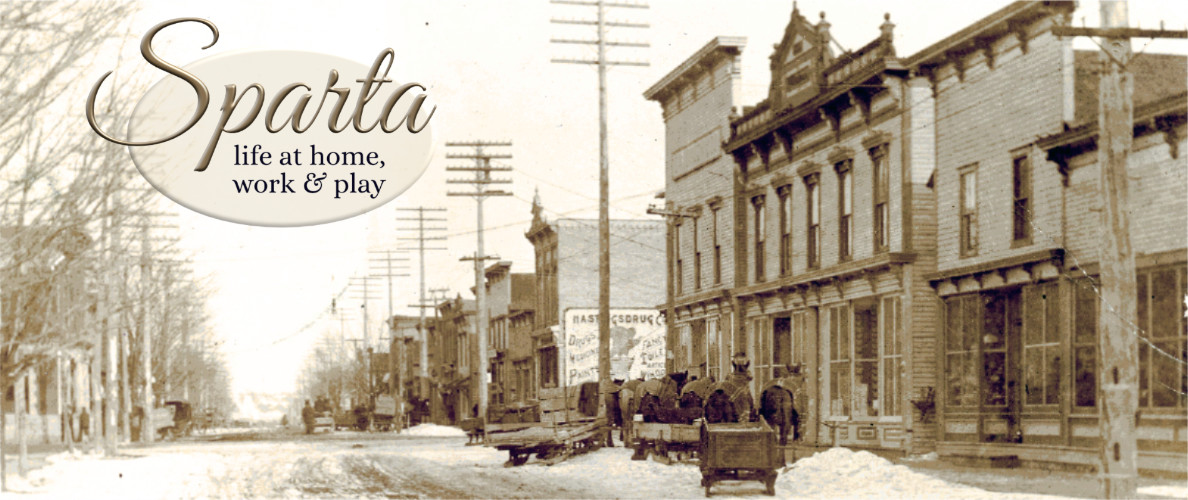


Competitive Spirit "Nelson A. Shaw: Horse Sense"
Businesswomen Sparta's Millinery Mavens: "Catherine Roberts & Rose Adelia Gaut: Mother-Daughter Hatters", and "Dora May Clute: Self-Made Woman"
Milo & Ben The stories of two friends and early Sparta businessmen: "Milo Bolender's Pharmacy" and "Dr. Benjamin Zudzense & His Monkeys" with "Pinckney Paints the Town"
Main Street Merchants "Charles Henry Loomis", "Frank Cnossen: There's Friendship in the Cup", and "Hugh Finch: Where You Always Do a Little Better"
Hometown Heroes "George W. Powers Murdered Lawman" and "Mad Dogs & Marshal Meeker"
The Highway Arrived State Street corridor and post-war growth: "Camp Boys Come to Town" and "Sparta Builders" addressed the housing shortage
Merry & Bright How we celebrated: "Charlie Badgerow: Two Christmas Gifts", Christmases Past", "A Very Sparta Christmas", "My Christmas Memories", and "Sparta's Easter Bunny Helper"
Before Alden Pinckney began his paint and wallpaper business in the old Symes building at 33 North Union in 1940, his father, Frank, and older brother, Arzie, spent a memorable summer painting a house in town.
Franklin P. Pinckney, born in 1856 at Lyons, Ionia, Michigan, was the son of Elijah, a carpenter, and Susan (Soule) Pinckney. Married life began when Frank took Miss Ida A. Black for his wife in 1876 at Moorland township in Muskegon county. The 1880 Federal Census found the young couple at Chester, Ottawa, Michigan, with their infant son, Clarence Henry. Another son born the following year at Lyons in Ionia county was named Mount Vernon, but chose to be known by his middle name or just 'Vern'. The curtain opened for Arzie L. on November 26, 1886, at Trent township in Muskegon county followed by the remaining children who joined the family at Sparta: Maude Olive in 1890, and in 1894, along came Alden. When the 1900 Federal Census was enumerated, it noted Frank Pinckney was employed as an "oil rubber" at Welch's Folding Bed Factory in Sparta.
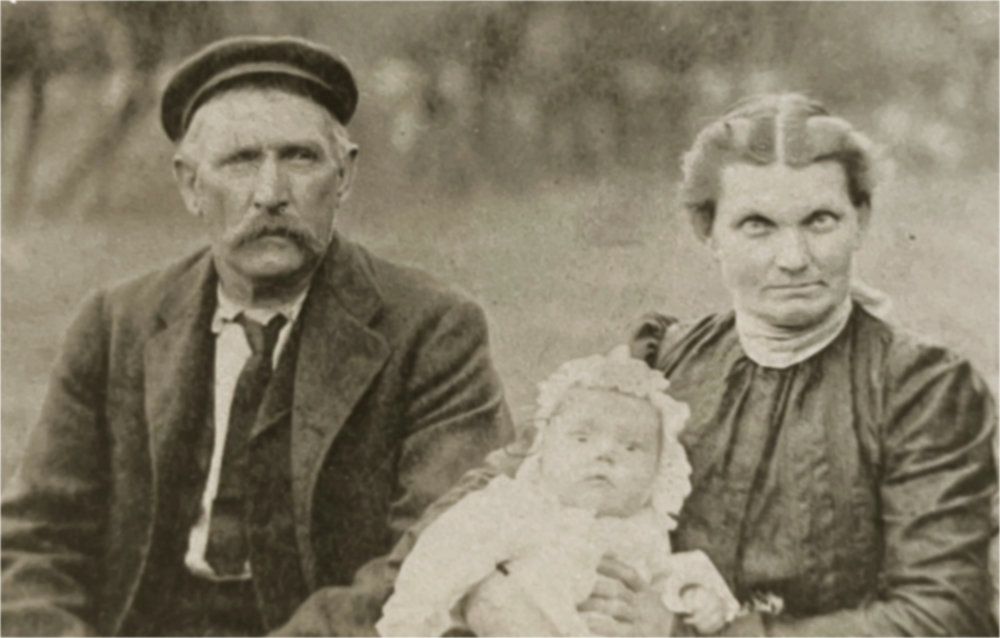
Arzie's parents, Frank & Ida (Black) Pinckney--courtesy of the Harley-Mink family
"At sixteen, Arzie decided to quit school and go to work. The first day on the job he cut his fingers off!" B.C. Cumings related his grandpa's cautionary tale--the moral of which was to stay in school. "The missing fingers were on his right hand. All he had left was his thumb and part of his first finger... to the first joint. The others were gone."
Granddaughter Diane (Cumings) Boone added, "He was working in a sawmill when he lost four fingers. His hand had to be kept elevated. So his mother sat up with him at night to make sure it remained elevated." With clear admiration, she added, "He never let that stop him from accomplishing anything in his life."
The job of painting the home of Dr. Benjamin Zudzense was an opportunity for Frank to pass along skills to his son, who would gain job experience and a good reference for future work. Most likely, the job took place in 1903, when he was almost 17 years old and his hand had healed.
Arzie began his (5 Feb 1969) column for The Sentinel Leader entitled "More about Dr. Zudzenze" with "I remember that my father and I painted his house one summer." His next statement suggests he was indeed an accident-prone youth.
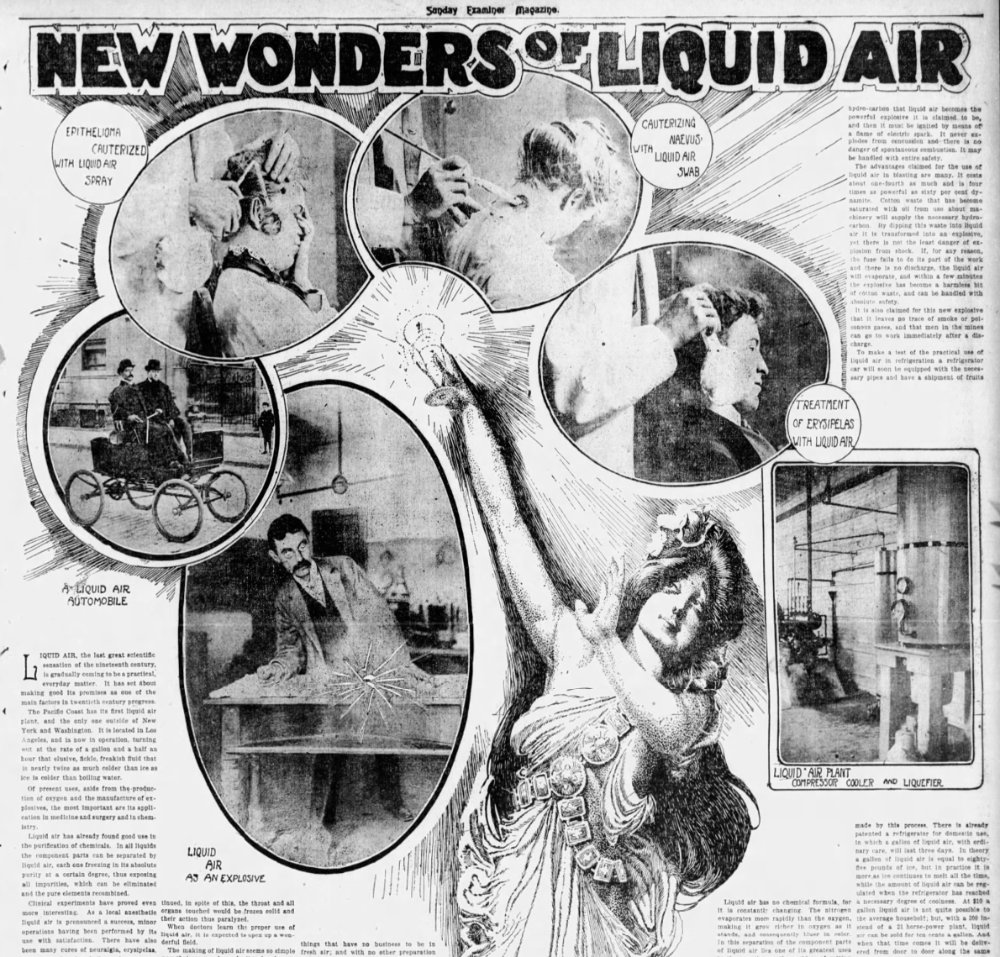
Liquid Air uses--medical, automobiles, explosives--illustration The San Francisco Examiner, 7 Dec 1902
"I also remember splitting a shingle to make a paddle. I used my father's knife which he always kept as sharp as a razor. And, in kid fashion, I was whittling towards myself and I split the fleshy part of my left thumb... and I mean that, I really split it."
"The doctor happened to be at home and he took me into his office, got out what looked like one bottle inside of another, took a swab, dipped it into the fluid and just wiped it over the cut and my thumb and the blood was frozen instantly. Then he put in six stitches and bandaged it up and told me that I must not take it off for three days. He said that it might get very painful, and if it did, I was to put it in a cup of hot water to ease the pain. He wasn't kidding. When my thumb began to thaw out, it sure was painful. He told me that the stuff he put on my thumb was liquid air. I remember asking him how they could get liquid air but I don't recall how he explained it."
Liquid Air
A May 13, 1899, item which appeared in numerous newspapers across the US and Canada described the phenomena of liquid air. Made from oxygen, liquid air is similar to dry ice, which is made from nitrogen. "Not the least interesting of the applications of liquid air is to cauterization in surgery. At 312 degrees F. below zero, it utterly kills the tissue, leaving a blister not unlike a burn, although it does not actually burn. It has been already successfully tested in cancer. Its cost is much less than that of ordinary cautery, while it is more efficient and its action can be readily controlled."--Rochester Democrat and Chronicle, New York.
Early on, it was viewed as somewhat of a novelty with public demonstrations and articles. Besides medical uses, it was discovered liquid air could power motors, automobiles, and had potential as an explosive. "Charles E. Tripler, of New York City, reduces the air of his laboratory to a clear, sparkling liquid that boils on ice, freezes pure alcohol, and burns steel like tissue paper. And yet Mr. Tipler dips up this astounding liquid in an old tin saucepan and pours it about like so much water. Although fluid, it is not wet to the touch, but it burns like a white hot iron, and when exposed to the open air for a few minutes, it vanishes in a cold gray vapor, leaving only a bit of white frost."--Liquid Air.--Comprehensive Article Relative to the New Element.--McClure's Magazine, republished in The Oskaloosa Herald, Mahaska County, Iowa (21 Feb 1901)
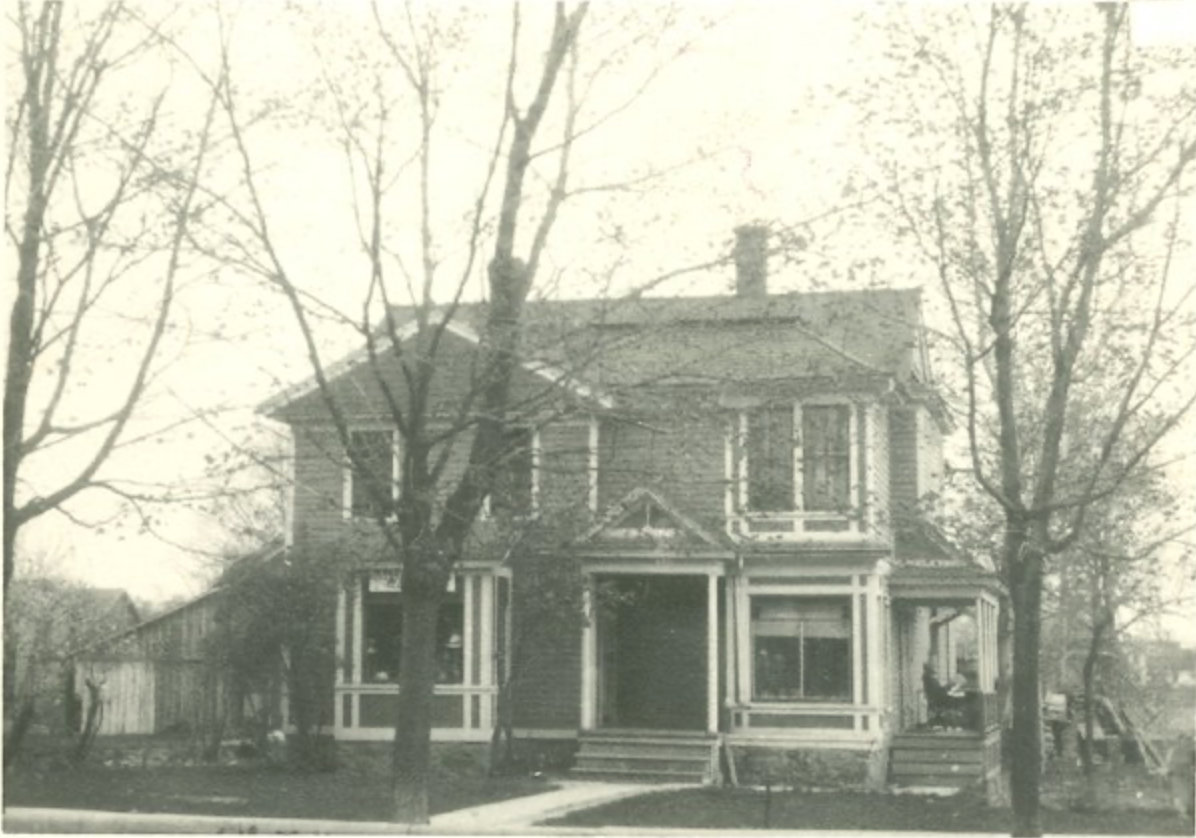
Dr. Benjamin Zudzense' home when later owned by Noble & Rose Gaut--STHC archive photo
The article went on to describe the discovery "...in 1877 when Raoul Pictet submitted oxygen gas to enormous pressure combined with intense cold. The result was a few precious drops of clear bluish liquid that bubbled violently for a few seconds and then passed away in a cold white mist." An Englishman, Professor Dewar, invented a glass bulb apparatus to keep small amounts of liquid air and prevent evaporation. It consisted of high vacuum between two small glass vessels with a singular neck--just as Dr. Zudzense brought out to treat Arzie.
Monkey See...
"I remember that it was my job to paint the inside of the monkey's cage," Arzie voiced his apprehension, "but even though he promised me that the monkeys would not hurt me, I would not go inside of that cage until he locked them outside of the cage. So he let them out and they just sat and watched. I got ready to paint over the cage, put a plank on top of the cage, and fixed a ladder, then took up a full gallon pail of paint."
"Just as I was getting ready to start, father came around the house and said that the doctor wanted us to help him move the big box that his organ came in. So I got down and we went around to his woodshed to see where it was. It was right in the center of the floor so we tried to move it but it would not budge. The doctor had a vocabulary (that would make old Capt. Kidd blush) when he got excited and he sure let loose of it that day. He was on one side of the box and father and I were on the other side so he couldn't see us and father laughed so hard that he just leaned up against the box and didn't push a bit."
"Finally we got the box where he wanted it and he was going to cut off a board so he went into the house and got a hand saw. I asked him if that was what he used to cut folks' legs off. He said, "H---, no I use a better saw than that. This saw you can't keep sharp enough. Just look at it. I just bought it from Charlie Loomis' Hardware Store and the D--- thing is only tin."
"I went back to my job and when I got near the cage, I noticed a puddle of paint on the ground. I looked up and the monkey had my brush and he was painting the house to beat the band, just scrubbing the brush up and down with both hands. The doctor came and made him give me the brush. Although it was a new brush there wasn't only a dozen hairs left in it."
"We wondered how he ever managed to tip the gallon pail over but Mrs. Zudzenze was sitting near the window and saw what happened. She was unable to walk and she couldn't call anyone so she said that the monkey could reach through the wire. At first he could not reach it with his hand so he turned around, stuck a hind leg through and reached the edge of the pail and tipped it over. Then he worked the brush around until he could get hold of the handle. After that, it was smooth sailing."
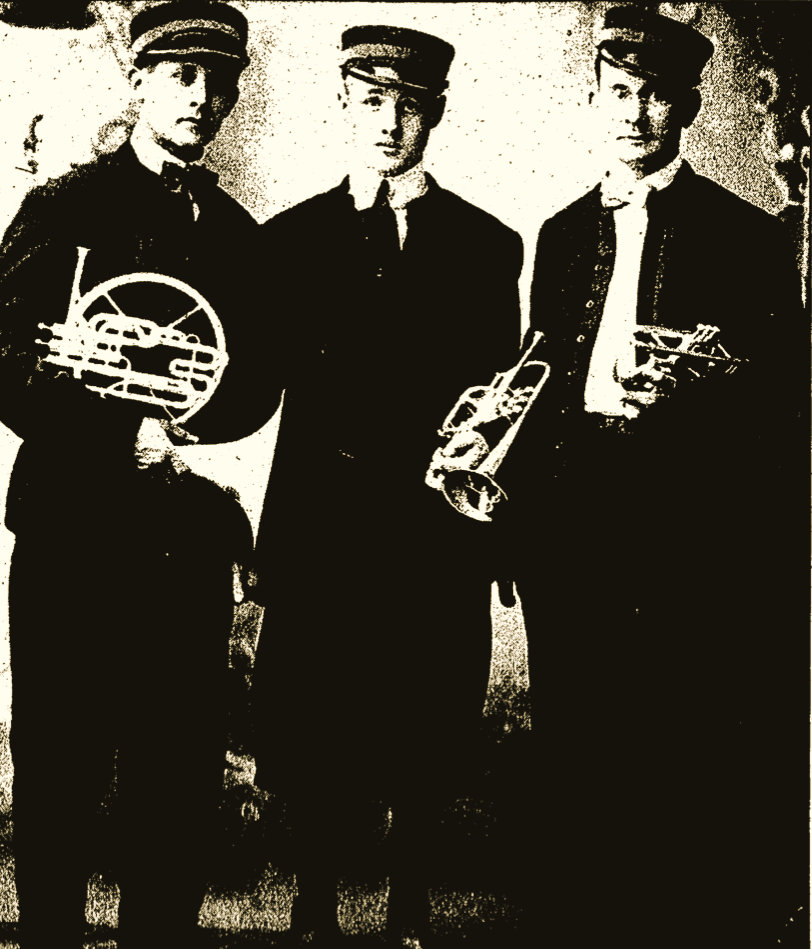
Meryl Shaver, Roy Maier, & Arzie Pinckney in 1910 circus band--The Chelsea Standard, 26 Dec 1996
Arzie's mother passed away on October 13, 1905, from Typhoid Fever just before he turned nineteen. Three years later, his father married his brother George's recently widowed sister-in-law, Adelaide Lucy (Cleveland) Tucker. Arzie took a room at Mary Walcott's boarding house and made his own way as a machinist at a Sparta factory. In April 1910, he was recorded in the Federal Census at the boarding house along with fellow boarders and work colleagues, Arthur and Carle Trofast--a pattern maker and moulder--who were recent immigrants from Sweden.
Dream a Little Dream
Shortly after the census was recorded, Arzie made a life-changing decision to follow his dream to become an entertainer and joined a small touring circus as a musician. There, he met and became good friends with Roy J. Maier, a talented thirteen-year-old coronet and saxophone player from Chelsea, Michigan. Double duty was required of the musicians, so preparations were made inside the Maier barn for the boys to learn and practice high-flying trapeze tricks. If you think Arzie took a pass on learning the trapeze, you would be mistaken and B.C. Cumings confirmed, "Arzie did chin ups on the trapeze with his good hand!"
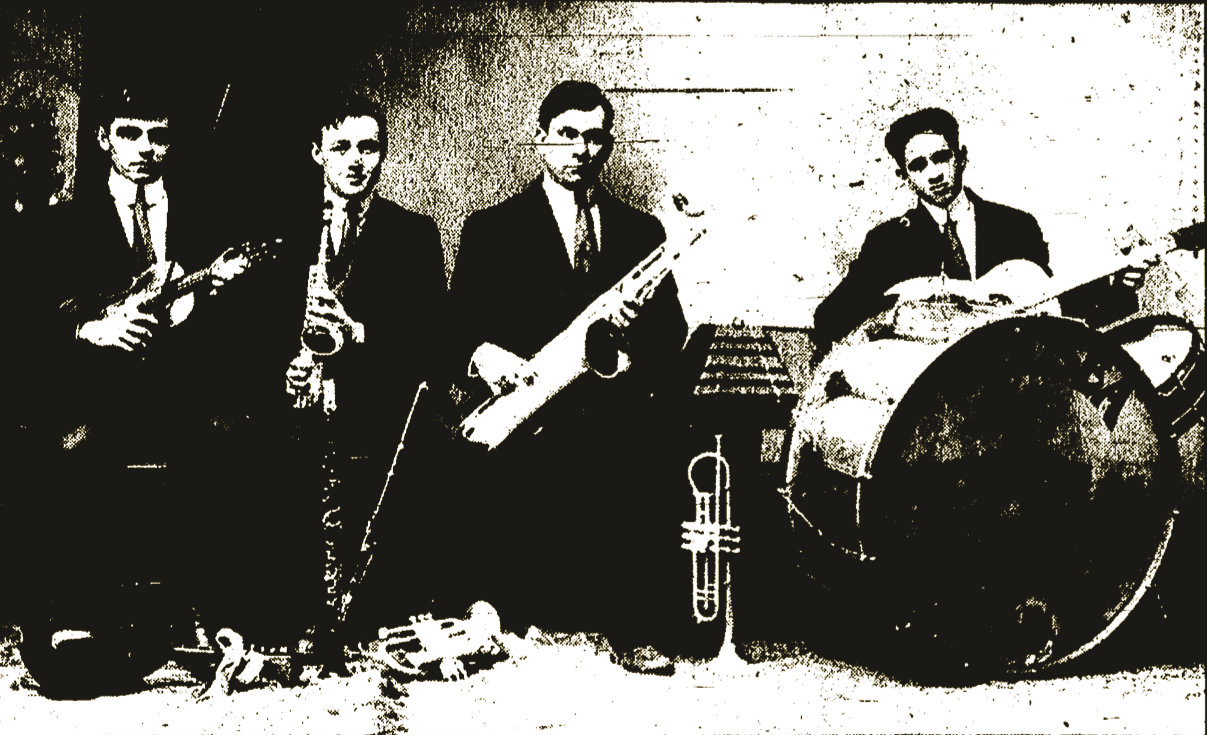
George Kaercher, Roy Maier, Arzie Pinckney, & Clarence Raftery formed Chelsea Imperial Orchestra in 1910--The Chelsea Standard, 2 Jan 1997
As cold weather brought the circus season to a close, Pinckney and Maier along with fellow musicians George Kaercher and Clarence Raftery formed the Chelsea Imperial Orchestra. They played at school concerts, college dances, parades, and as a square dance band. "The band was on the way to a barn dance south of Chelsea when the drum rolled out of their truck right about where Chrysler Proving Grounds entrance is now," Kaercher's brother told The Chelsea Standard for a story entitled "The Way It Was--Chelsea Imperial Orchestra" featured in 1997. "As it rolled along it went bouncing and 'booming' out into the field and it sounded like someone was playing it. Luckily it was not damaged and they went on to the barn dance." The orchestra quickly grew to twenty members who performed until about 1920.
Remarkably, Roy Maier was proficient on at least ten instruments. His professional future would involve vaudeville in the Windy City and a friendship with Bing Crosby as they toured the country with the famous Paul Whiteman band for four years. Later, Roy joined the Ziegfield Follies, played in radio orchestras, and performed with the Chicago Symphony.
The Chelsea Standard reported that Arzie joined the Great Bink Show in September 1913, which was a popular vaudeville troupe that toured northern Michigan. According to promotional details, George Bink was "a slack wire walker, who juggled a half dozen vicious looking butcher knives while balanced in midair." Prior to the rise of movies with sound, vaudeville was a wildly popular style of entertainment. It encompassed a wide variety of acts which included: plays, skits, comedy sketches, magicians, jugglers, acrobats, animal acts, pantomime, clowns, cowboys, female impersonators, child impersonators, song and dance numbers, and striptease. Shows were presented at traveling circuses or in elaborate theaters called 'vaudeville houses' where audiences would experience an assortment of performances in one program. It was not uncommon for theatrical comedy offerings to involved female roles presented by male actors. Between shows at theaters, motion pictures were shown as a means to clear out the crowds--until their popularity rose to the level of becoming the main event and eclipsed vaudeville.
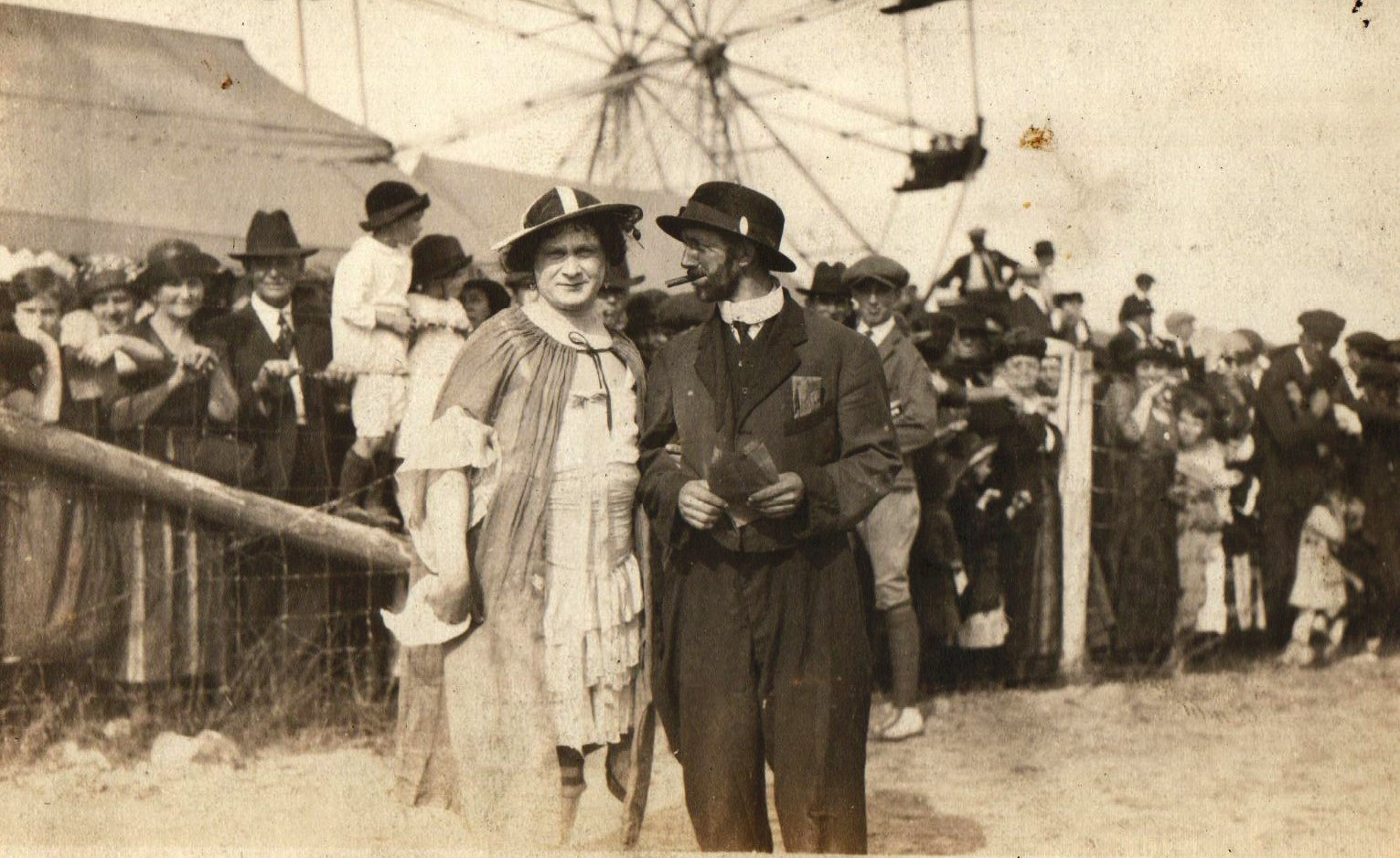
Arzie and a fellow circus performer in character--photo courtesy of the B.C. Cumings Collection
While away, he continued to keep in contact with his Sparta friends and made regular visits whenever he could in between shows. "I don't remember what year it was but one spring I was having a few weeks at home. We had closed our winter show and it was some time before we were to start rehearsing for the summer show so I came home on vacation." Thomas Ferrick, an electrician, was the proprietor of the Vaudeta movie house at Sparta and operated it for several years with silent films. On this visit, he asked Arzie to stop by, as he sought input on the addition of a vaudeville act to his Saturday night shows. Arzie advised him to create a stage and a draw curtain as well as put Tom in contact with a talent booking agent he knew in Grand Rapids. It didn't take long for Tom to complete the project "...then he asked me if I would put on the first show and I told him I would," Arzie fondly recalled. "I did a comedy number called "My Dear Old Mother and I", only I didn't have the dummy with me so I could only do the monologue and the songs that went with the act. It is what is called in the theater vernacular as Silly Kid or a Toby character. It went over well and Tom was in the vaudeville business. He had a lot of good acts, one every week on Saturday."
"I did not stay very long after that as I was called back to Detroit to rehearse for the coming summer season but I did see a few of his shows."
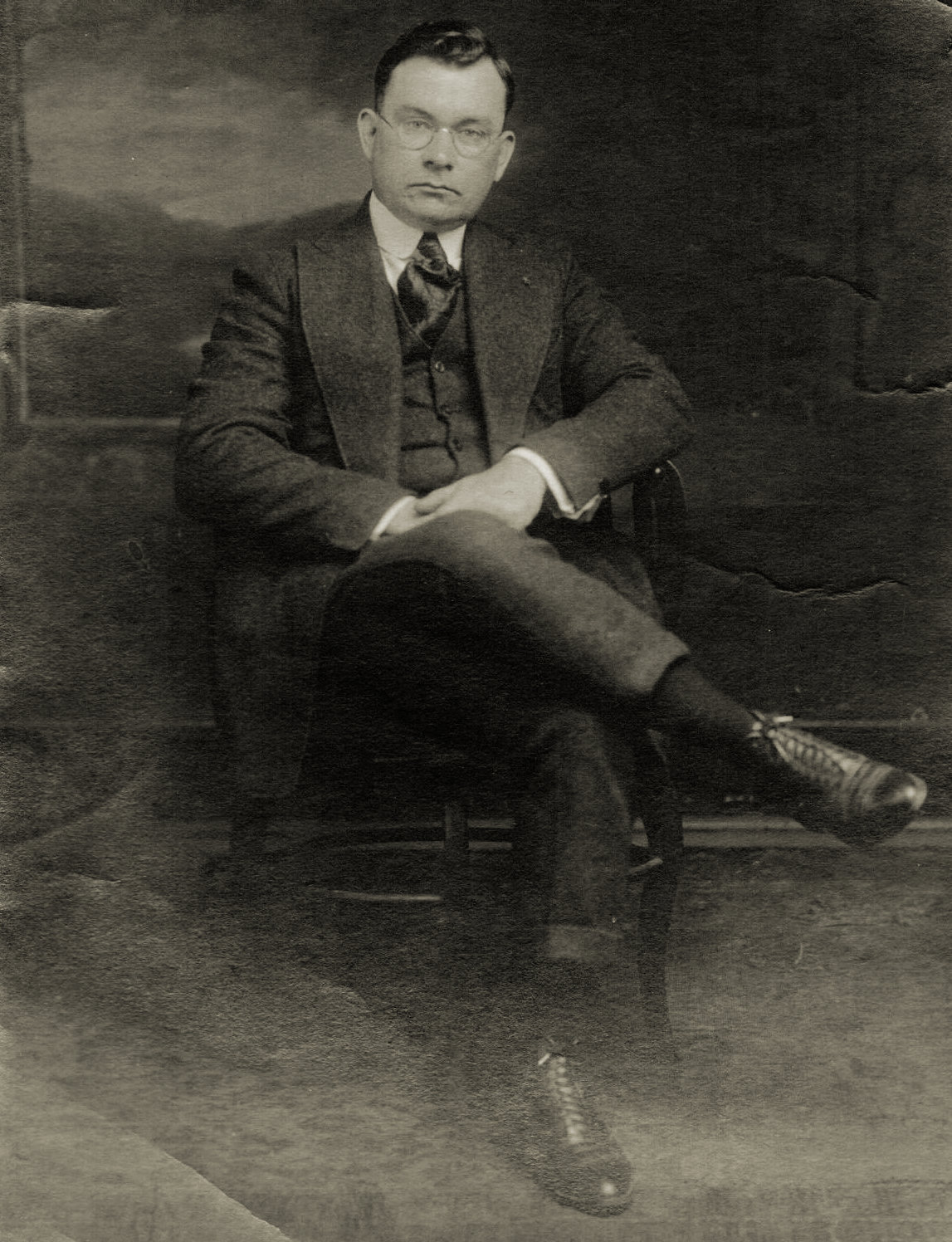
Arzie in a reflective moment--photo courtesy of the B.C. Cumings Collection
The forerunner to Pontiac Motor Co., The Oakland Motor Car Co. of Pontiac, Michigan, owned by General Motors, employed Arzie as a receiving clerk. On June 5th, 1917, he completed his World War I draft registration card. Due to the accident which cost him four fingers, he was exempt from the draft. In spite of physical challenges, he advanced to an assembler position by 1920 and was promoted to a manager two years later.
In 1916 while at Pontiac, Arzie volunteered as Scoutmaster with Troop 8 of the Boy Scouts. As Deputy Commissioner in 1922, he started and directed a Boy Scout Orchestra. In 1923, Arzie returned to Sparta where he worked with others to organize Troop 1 with thirty-two scouts. A tribute to Arzie article in a 1937 issue of The Sentinel-Leader described his commitment to the success of Scouting at Sparta: "For a great many years the required amount of money to finance the Scouts was obtained to a great extent by plays and other forms of entertainment planned and directed by Arzie." By 1937, 300 boys had participated in the organization at Sparta with sixteen attaining Eagle Scout rank. As a Scoutmaster, Arzie served for twenty-four years in all.
At the age of thirty-nine, on July 26, 1926, he exchanged bachelor life for a wife, Bessie Elena Burgett, the former Miss Putman. A step-father to two sons and a daughter: Roy Cyrus, Kenneth Glenn, and June Eileen, the couple increased their family when blessed with two additional children: Maxine Rae and Arzie Wendell. He provided for his family as a cost clerk at the furniture factory then a stock clerk at the Muskegon Piston Ring.
In addition to Boy Scouts, Arzie devoted his time to work with the American Legion and directed numerous plays for the purpose of fund raising. The American Legion Players raised funds to assist with the rebuilding of the Methodist Church and for Legion welfare projects in the community.
"He was remarkable in that he didn't let losing fingers stop him," B.C. shared his memories how his grandpa made jewelry and raised rabbits as small side jobs. "He was always up for vaudeville. After Brown's Opera House closed, Mrs. Brown let him keep a dressing room. He would sometimes take me there to see the costumes."
"He could strike up a conversation with anyone. Even into his old age he kept in contact with many of the boy scouts in his troop at Pontiac. He loved being around young people. Being loved and respected by young people meant a lot. Among his papers, was a box of letters received from seminary students and military soldiers thanking him for his thoughtfulness and gifts."
"He was great fun and loved a good story," B.C. remembers his grandpa. "The old guy never grew up."
Fortitude. Determination. Kindness. These are words which described the character of one of Sparta's early pharmacist businessmen. A man, who in spite of disastrous events, picked himself up by the boot straps and pressed on until he achieved his goals. A man who lived by the Golden Rule and demonstrated a spirit of genuine goodwill and compassion towards his fellow man. Someone whose presence made Sparta a better place for all to call "home".
Milo Bolender
October 31st, 1853, marked the birth of Milo Bolender in Stark County, Ohio. At various times, his father George toiled as a saddler, a carpenter, and a farmer to provide for his family. Milo's mother was Harriet Keziah Frank. The boy learned the value of hard work while growing up on the farm, however, he had been a sickly child and aspired to have an indoor career. George moved his family north to a dairy farm in Clinton County, Michigan. After high school, Milo worked at a machine shop for seven years then managed the family dairy farm with his father for the next three.
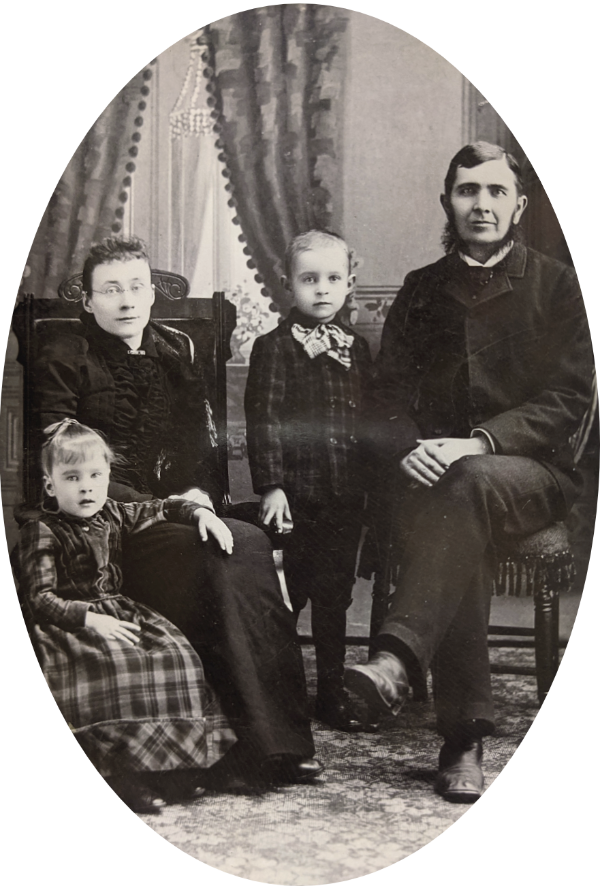
Elva, Clara, Edson & Milo Bolender aprox 1896 - portrait courtesy of Bill Kelly
Springtime of 1880 arrived. Milo bid his parents and family "good-bye" as he left home to seek opportunities at Hubbardston in Ionia County, Michigan. Quickly, he found work on a farm until a job opening to clerk for Dr J.J. Robbins at his drug store presented itself. Hired, Milo found he was well-suited to the work and once established he married in 1883 to a local girl, Clara Alice Mitchell. On the 21st of October in 1885, Milo became a partner when he purchased a half share in the business, thereafter known as "Robbins & Bolender". Four years later, Milo bought out the doctor's interests upon his retirement.
A savvy, prosperous, well-respected businessman, Milo was elected to serve in various capacities as Hubbardston's village treasurer, on the board of trustees, the township clerk, and village president.
A daughter, Mary, was born to Milo and Clara in 1884, but she only lived for one day. The couple welcomed the birth of a son in 1886 whom they named John Edson. In 1892, a daughter, Elva, joined the family and in 1897, youngest son George Karl arrived. Never married, Nora Irene Mitchell who was Clara's sister, lived with the family for most of her life and worked at Milo's pharmacies.
Milo operated the drug store with great success until a fateful night in May of 1900. Events were described in Representative Retailers: Milo Bolender, Dealer in Drugs and Medicines at Sparta published in the February 13, 1901 issue of Michigan Tradesman:
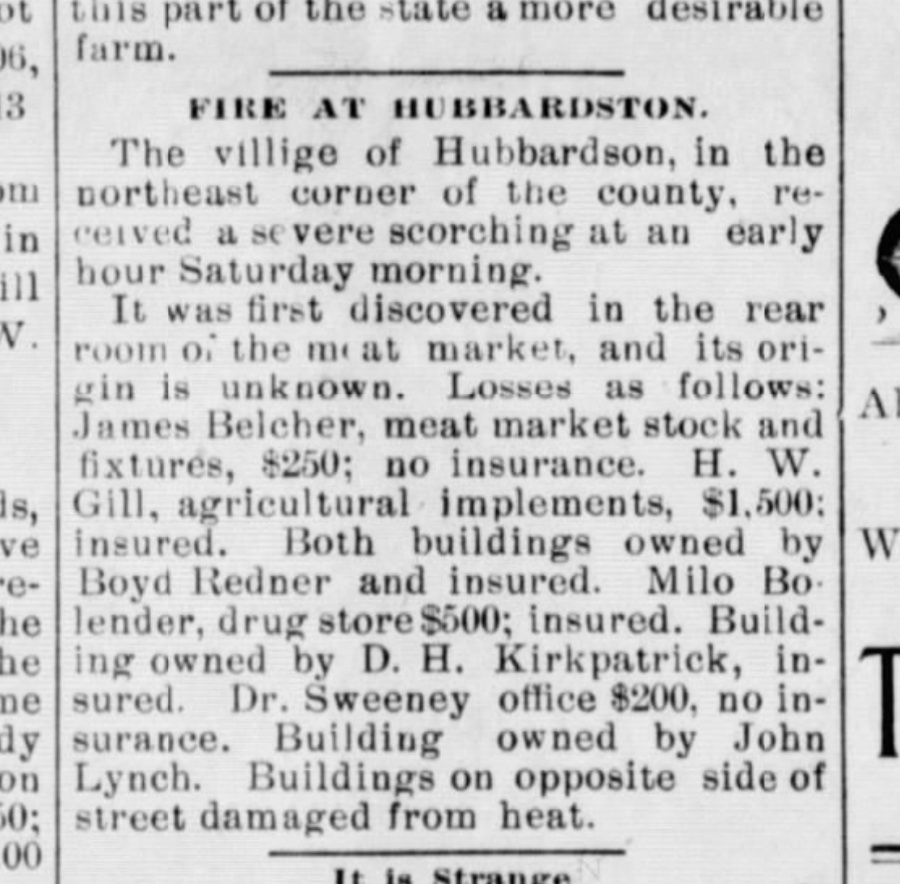
The Belding Banner's June 18, 1900 report
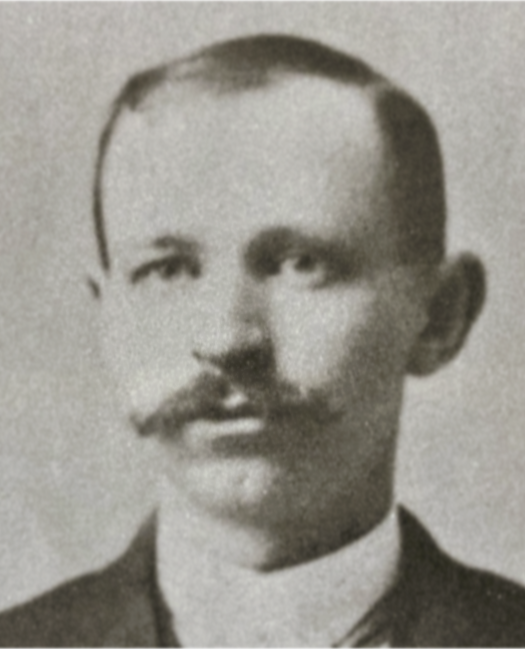
Rodney A Hastings, druggist
Rodney Hastings
Hastings Drug Store occupied the southeast corner of what is now East Division and Union Streets. During the decades in the latter half of the 1900s, the location was widely known as Wolf's Drugs. The west-facing exterior of the brick building was painted in bill board fashion (as can be seen at the top of this page) with an eagle upon a pharmacist's mixing container surrounded by words to describe the products stocked: "Drugs, Medicines, Paints & Oils, Wall Paper, Fancy Toilet Articles, Window Shades, Stationery."
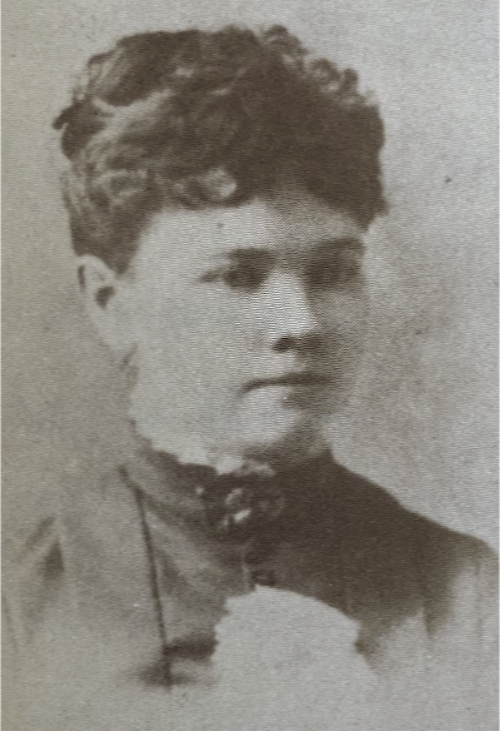
Hattie E Thurston, 1881 Sparta High graduate and wife of Rodney A Hastings
Rodney A Hastings was born at Sparta on August 31, 1863, the son of a farmer, Rodney Durkey and Susan F (Nippress) Hastings, the widow of Hiram Doty. The father was born in 1821 at Swanzey, Cheshire, New Hampshire. He migrated west to Sparta with a sister, Susan, and in 1850, they resided with Jonathan Nash. Rodney married a lady named Fanny Theresa (last name unknown) who died in 1860. The following year, he wed Susan Doty.
The senior Rodney was said by Arzie Pinckney, "to have dabbled in real estate by the looks of some of the abstracts of the houses in Sparta". One of his earliest investments was a joint venture with David Martindale on November 28, 1845, that consisted of a lot on the north side of Division Street just east of the building where the Post Office would later be located.
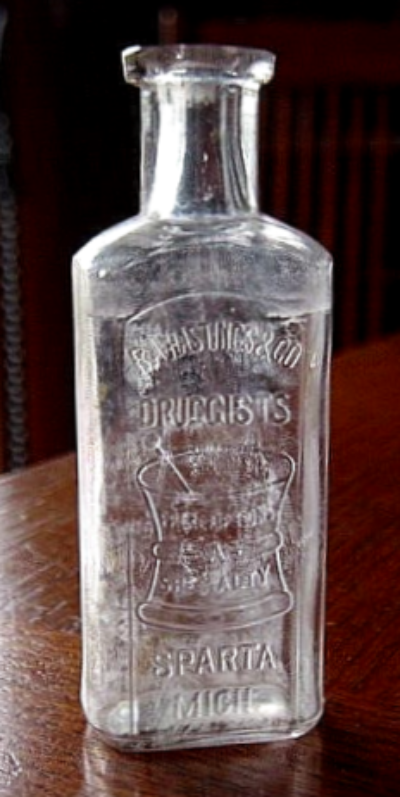
R.A. Hastings & Co, Druggists, Sparta, Mich prescription bottle courtesy of the Karl Nickolai Collection
A promise of bounty land was offered to soldiers of the Revolutionary War, War of 1812, Mexican War, and Indian wars between 1775 and 1855 by the federal government. It also served as an enticement to settle wilderness areas. Either the soldier or his heirs could claim the land and upon approval of an application, would be given a "warrant". Some which remained unclaimed were surrendered and others who sought to obtain a land "patent" could. Most soldiers never lived on their claim, but instead, chose to sell it. On June 1, 1850, Mr. Hastings along with C.A. Harper went to the Ionia Land Office where they became patentees for a military land warrant awarded to William K Revere. It consisted of two parcels which amounted to 169.48 acres in Sparta Township. The virgin land was situated between what we now know as Indian Lakes and 16 Mile Roads with the western corner clipped by M-37 while the midsection is dissected by the railroad and Ball Creek Avenue.
By the 1860 Agricultural Census, Rodney D Hastings was recorded with 240 acres of farm land holdings, livestock, and farming equipment valued at $6,750, which in 2023 dollars is worth $241,371.05.
Over the next dozen years, his land holdings increased to include tracts elsewhere in the township. Tragically, the father, who was severely injured while he worked with his neighbor, Jonathan Nash, to dam the creek (as H.M. Sleeper described above) died the same year as his only son's birth.
At eighteen, Rodney boarded at Balcom's Hotel while he attended school in Sparta when the 1880 Federal Census was enumerated. During the late 1800s and early 1900s, it was a common practice of families who lived a distance from the village to arrange for older children to stay in Sparta through the week in order to gain an education. Other guests recorded at the hotel included D.J. Wallace, Physician, and W.P. Sessions, a "Man of Leisure".
Young Mr Hastings completed his education and became a druggist then, on April 11, 1882, he married Hattie E Thurston. Prior to the establishment of his own pharmacy, he was employed by E.W. Norton & Co as a drugist at Sparta. This was the Reverend Erastus W. Norton, a Freewill Baptist minister with a business investment in the local pharmacy. In August of 1887, he passed away. Frank Holmes married the minister's daughter, Lulah Norton, in 1891 when the marriage record provided his occupation as that of a "druggist". During the 1920s, Frank Holmes sat at the editor's desk of the Sentinel-Leader.
According to The Druggists' Circular and Chemical Gazette the R.A. Hastings Drug Co of Sparta was incorporated with a capital stock of $12,000 and 1,200 shares in 1896. The major stockholders were Rodney A Hastings with 566 shares, Ann Norton at 194 shares, and Frank M Holmes with 125 shares. Ann Norton was the widow of Rev Erastus W Norton and Holmes' mother-in-law. Rodney likely had a considerable sum of money as an inheritance from his father's estate.
An untimely death took Rodney on April 22, 1899, after at least three months of illness caused by the Grip, now commonly known as Influenza. In the settlement of his estate, an advertisement was placed in the Michigan Tradesman on June 27th, 1900, which stated: "FOR SALE--THE HASTINGS DRUG STORE at Sparta. One of the best known drug stores in Kent county; established twenty-six years; doing a prosperous business; brick building; central corner location; reasonable rent; long lease; belongs to an estate; must be sold. M.N. Ballard, Administrator, Sparta, or M.H. Walker, Houseman Building, Grand Rapids, Mich."
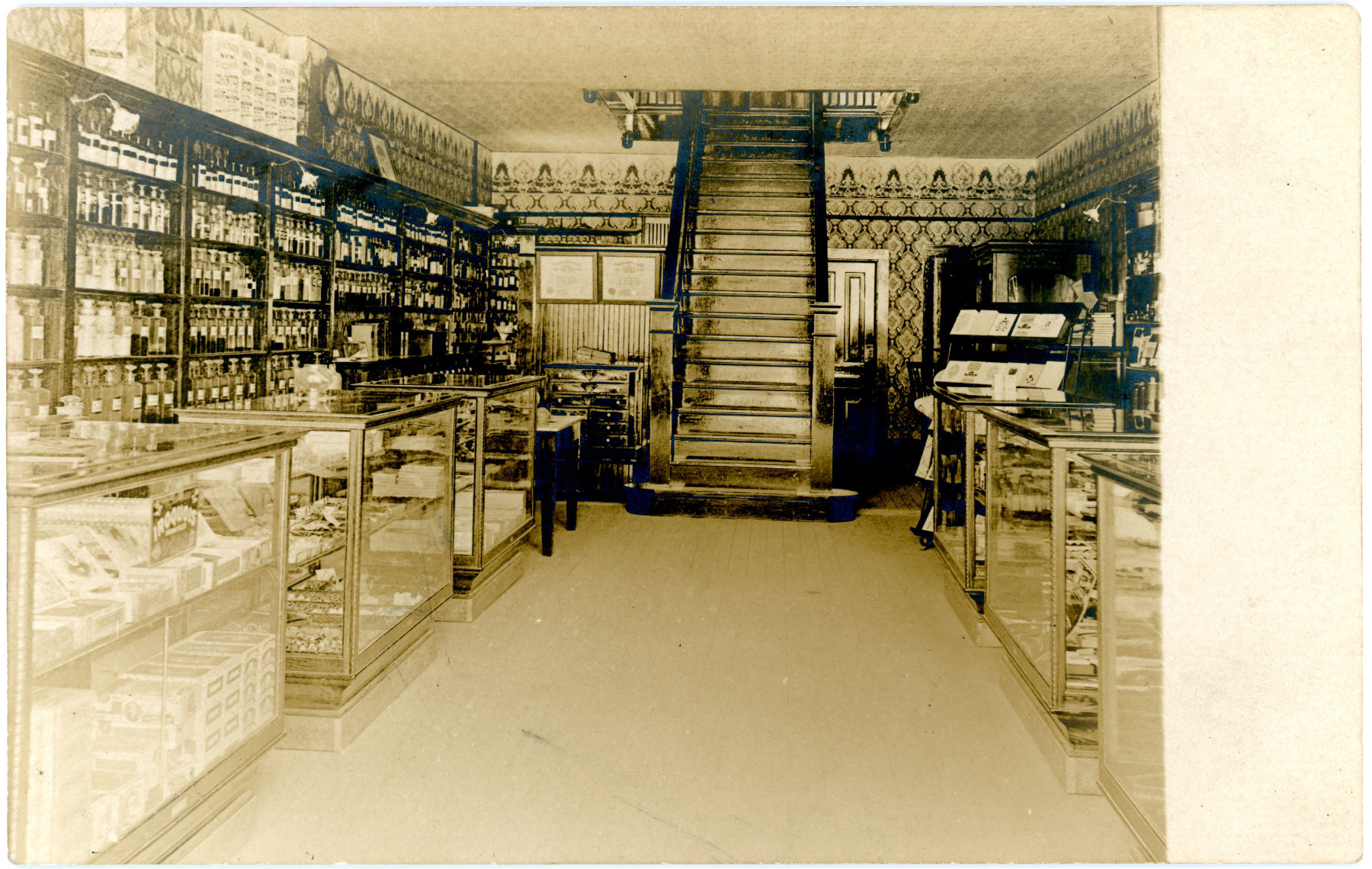
Interior view of Bolender's Pharmacy about 1906 courtesy of the Karl Nickolai Collection
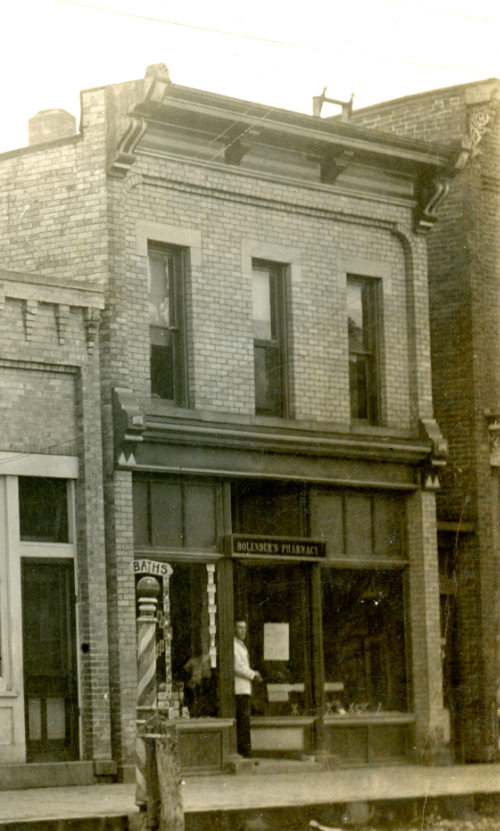
Bolender's Pharmacy as it appeared at about 1910-12 photo courtesy of the Karl Nickolai Collection
Bolender's Pharmacy
The timing of the availability of the drug store presented an opportunity for a fresh start for Milo Bolender at Sparta. Although he purchased the business and stock, Milo's arrangement was as a tenant in the former Hastings Drug Store building on the corner. The fact that the building was constructed of brick appealed to Milo and he stated so in his early advertisements.
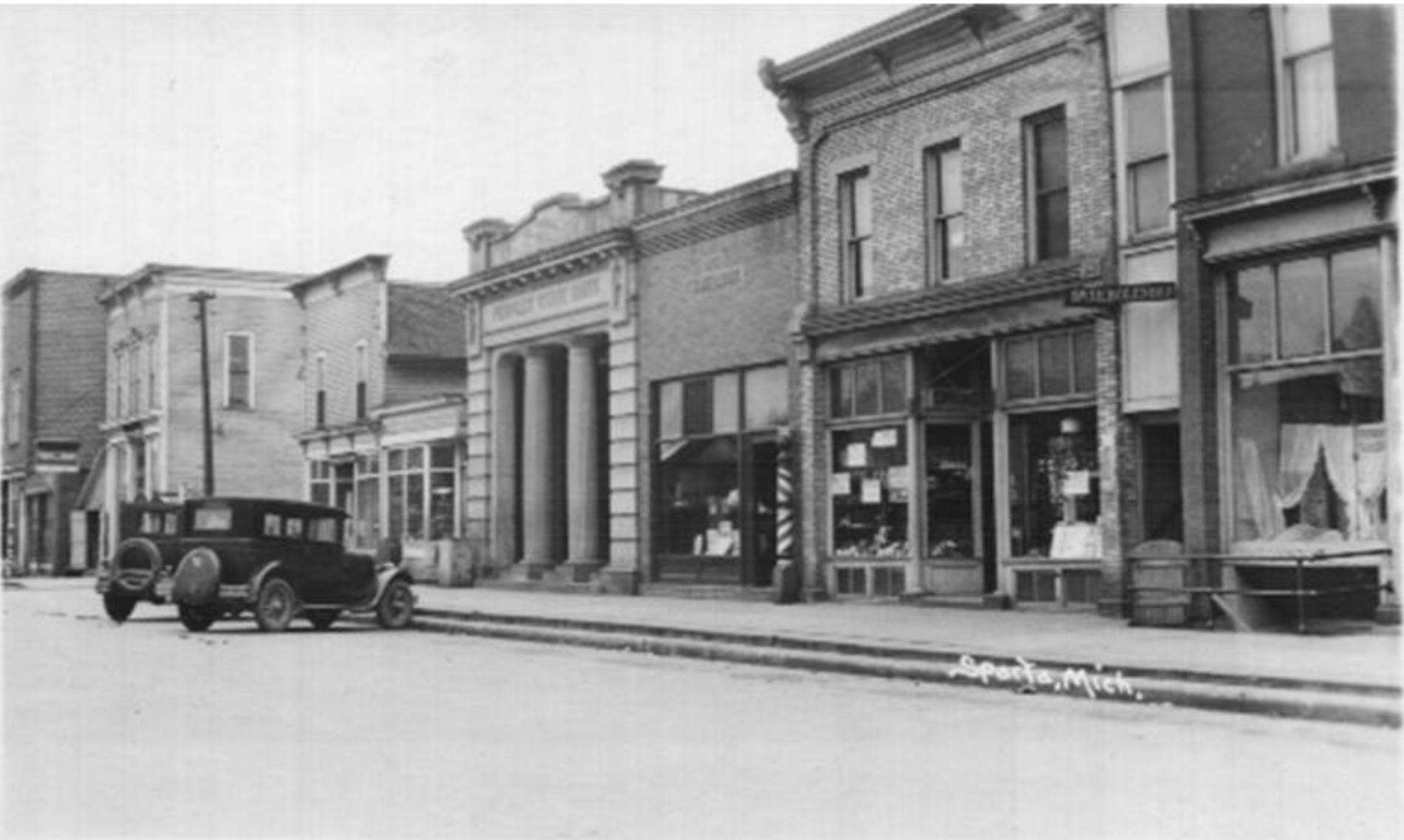
Businesses on south side of East Division, west of Washington: Peoples State Bank, F.D. Kellogg's Palace Barber Shop, and Bolender's Pharmacy - photo courtesy of Bill Kelly
Business was brisk. A few years later, an opportunity to own a storefront in Sparta's downtown presented itself when, in 1905, a two-story brick building just one door west of Frank Kellogg's Palace Barber Shop became available. It had previously been a candy and ice cream parlor with telegraph service operated for a short period of time by William Kensel. Milo outfitted it with built-in oak cabinets along both side walls, craftsman style wallpaper, and several glass display cases which flanked a handsome open oak stairway to the second floor he had constructed. This allowed for additional product displays upstairs, which expanded the versatility of the building.
The space was ideal for Mr. Bolender's use.
A variety of general merchandise was sold in additional to pharmaceuticals. Once settled at his new location next to the barber shop, Milo's 1906 postal-card Christmastime promotion included the message: "Buy your drugs and oils, toilet articles, soaps, etc.. here. Wall paper, stationery, school books, and rubber goods up stairs" which varied a bit between the beautifully handwritten cards. In addition to these products, the entrepreneur was the manager of Citizens Telephone Co Exchange, had the contract to provide telegraph service, and later rented out extra office space on the second floor of his business establishment. Responsive to customer requests, he added to the variety of his stock. For instance, in 1914, he advertised the addition of sheet music.
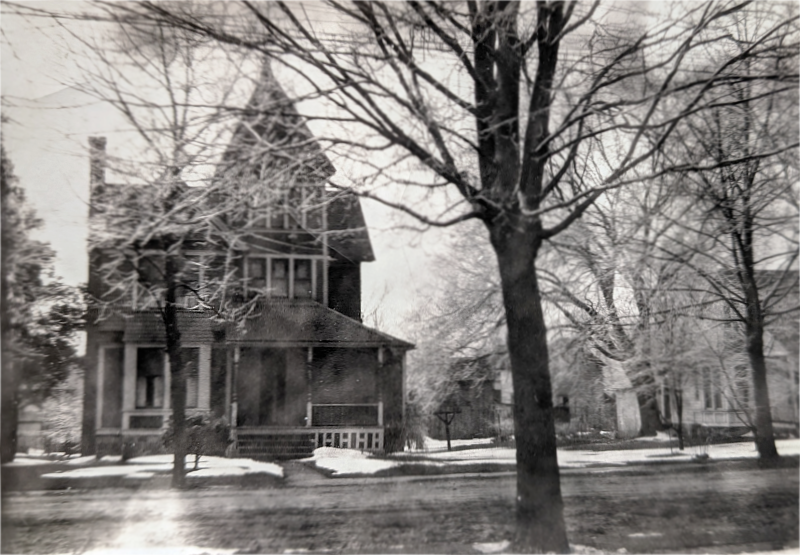
The Bolender Home was a classic Victorian three-tone painted lady located at what is now 58 W Division St. By the 1950s, it was re-sided with asbestos shingles and the front porch glassed in. Over the years, some of the others who later resided at the home included: Thurlow "Mack" McFall, Dr Henry Talmadge, and the Richard Farr families. Sadly, the beautiful house was destroyed by fire in 1983 - photo courtesy of Bill Kelly
Both of the Bolender sons graduated from the University of Michigan with medical degrees. Dr J Edson Bolender specialized in ear, nose, throat, and eye diseases with his medical practice located at Sparta in an office above his father's pharmacy. Dr G Karl Bolender became a dentist in Detroit. Daughter, Elva, went to college and taught school. She wed Neal Spangenberg. Early in their marriage Neal and Elva lived at the Spangenberg farm southwest of Sparta, which is still in the family today. All three of the Bolender children were blessed with musical talent: J Edson played violin, Karl on the cello and vocally, while Elva was a pianist and performed as a professional singer.
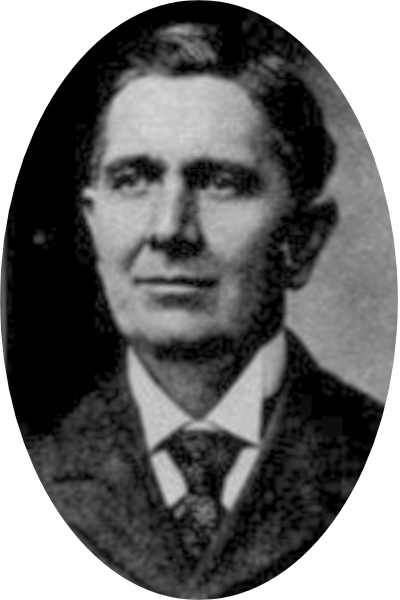
Pharmacist Milo Bolender
Elected as a Trustee on the local school board shortly after his arrival at Sparta, Milo served for many years. His support for good education extended beyond the board room to tangible actions as he encouraged youth to remain in school, earn a diploma, go on to college, and even provided material assistance or employment, if needed.
Milo's sister-in-law, Nora Mitchell, continued to live with the Bolender family as she worked at the pharmacy in the capacity of a saleslady and as a pharmacist. She was one of the earliest female pharmacist in Sparta, if not the first. After Milo's retirement, she found employment as a pharmacist at the Michigan Soldier's Home in Grand Rapids where, in 1942, she died.
Milo served the Sparta community as a trusted pharmacist for twenty-six years before he decided to retire, at which time he sold his business to the Perry Drug Co and Bert Perry, formerly of Ludington, took over the operations.
As he reminisced over the forty-one combined years as a druggist at Hubbardston and Sparta, the genuine care and concern Milo had for others earned him the highest respect. An August 1926 retirement article in Michigan Tradesman expressed his guiding philosophy. "It is a great thing for a merchant to know how to buy goods and it is a great thing, too, for a merchant to know how to sell goods, but it is a more wonderful thing for a merchant to know how to lay hold of the heart strings of the people about him--how to cultivate the friendship of customers in such a way as to build them up... There is more in life than the making of money."
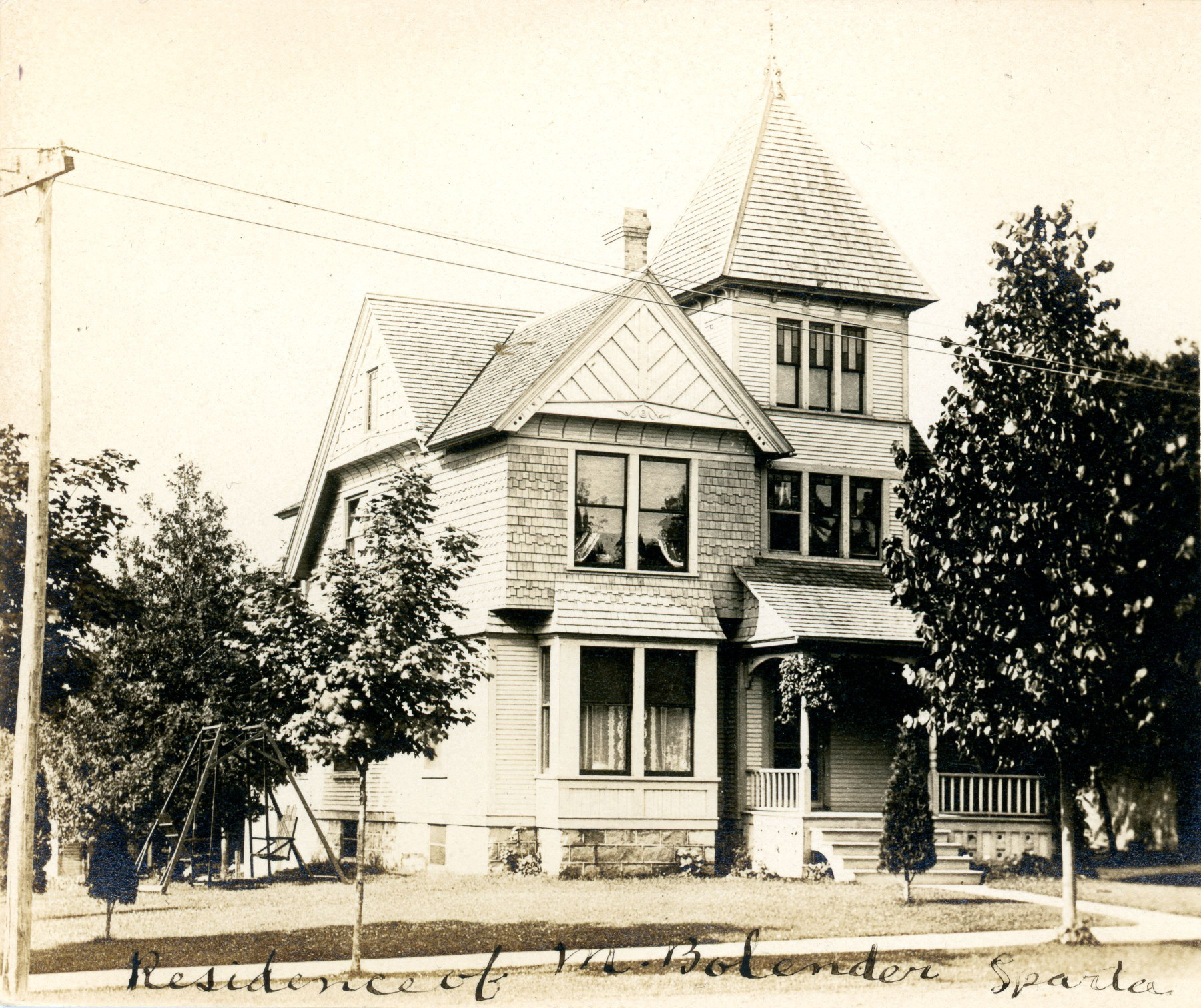
The Milo Bolender home at about 1906 courtesy of the Karl Nickolai Collection
If you think "nothing exciting ever happens in Sparta" then, my friend, you have not heard the incredible story of Dr Benjamin Zudzense and his Monkeys. Yes, that's right... monkeys! Pour yourself a cup of your favorite beverage, pull up a seat, and we'll start at the beginning.
It was the first of December of 1850 when Benjamin and Elizabeth (Thurling) Sussens' infant son, Benjamin James, was christened at the Church of All Saints in East Tuddenham, Norfolk, England. The gothic-styled stone church is said to date back to as early as the 13th century in a village of less than 600 souls. The boy was their youngest child with three older sisters: Elizabeth, Martha, and Emma--along with a brother--John Joseph.
Mr Sussens had a 70 acre farm with three hired men and a "house servant" at the time of the 1851 English census. Ten years later, the farm amounted to 60 acres while the father had two laborers plus a "daily maid" in his employ. Although little is known of Benjamin's youth, it was noted at ten years of age he was a "Scholar" as he attended school. The father died on September 25, 1870, and in 1871, Benjamin was a "lodger" at the nearby village of Hackford with the occupation of an "Organist" as he was counted in the household of Charles and Rebecka Cullum.
Eager to find a new path in life, the young man embarked on a grand adventure onboard a ship bound for North America. The 1900 US Federal Census stated his immigration took place in 1871, however, nothing else has been located as confirmation. Precisely how, why, or when he found his way to Kent County, Michigan, is uncertain. What is known, is as early as 1874, Benjamin James Sussens, a student from Courtland, Michigan, was enrolled to study medicine and surgery at the University of Michigan.
Benjamin's eldest sister, Elizabeth, lived with their widowed mother and aunt, Judith Thurling, who was a nurse, until the Sussens family matriarch passed away at the end of June in 1875. Three months later, on September 15th, Benjamin and Elizabeth boarded the SS Sardinian at Liverpool and sailed to the destination of Quebec, Canada. They arrived on the 5th of October. The ship manifest listed "Eliz Sussens" as a "Spinster" and Ben, a "Laborer", and both as "Steerage Passengers", the lowest classification under which a vast number of immigrants sailed.
Richard Coleman, also of Norfolk, was a traveling companion. He was the son of a veterinarian surgeon and was trained to assist the father. His older brother, Timothy Edward Coleman, was already a resident of Grand Rapids, Michigan, and worked as a lumberman and surveyor. In January of 1879, Timothy and Elizabeth were wed at Grand Rapids. The couple had no children and sadly she passed away on December 20, 1886, from cancer at Sparta.
Richard Samuel Coleman purchased a farm in Algoma township, married Nancy Christy, and they started a family. Soon he relocated into the village of Sparta where he became a veterinary surgeon. The Coleman family made their home near the intersection of South Union Street and Centennial Avenue.
From Sussens to Zudzense

The doctor's signature
Studies at the University of Michigan were resumed and Benjamin was listed among the students in 1876, 1877, 1879, and 1880, as a "non-graduate". He then took a sabbatical. While enrolled, he continued to use the last name Sussens. At around 1880, he began to use "Zudzense" as he was said to have determined his ancestors, who originated from the Netherlands, were known by the surname. The rest of the family stuck with "Sussens".
While on a Christmas trip to visit his family in England, The Bury and Norwich Post reported on Benjamin's activities on 21 Dec 1880:
In addition to possessing a passion for music, Ben had a keen interest in the cutting edge technology of the day. The first portion of his presentation sounds like an early travelogue and suggests he had toured the European continent and photographed the sights. The second topic related to his collegiate studies with a microscope. Thirdly, Edison invented the phonograph in 1877 and toured the United States with in the next year. It was the very first machine able to record and reproduce sound. Ben bought one of these primitive-looking devices and brought it with him to England. Amazing!
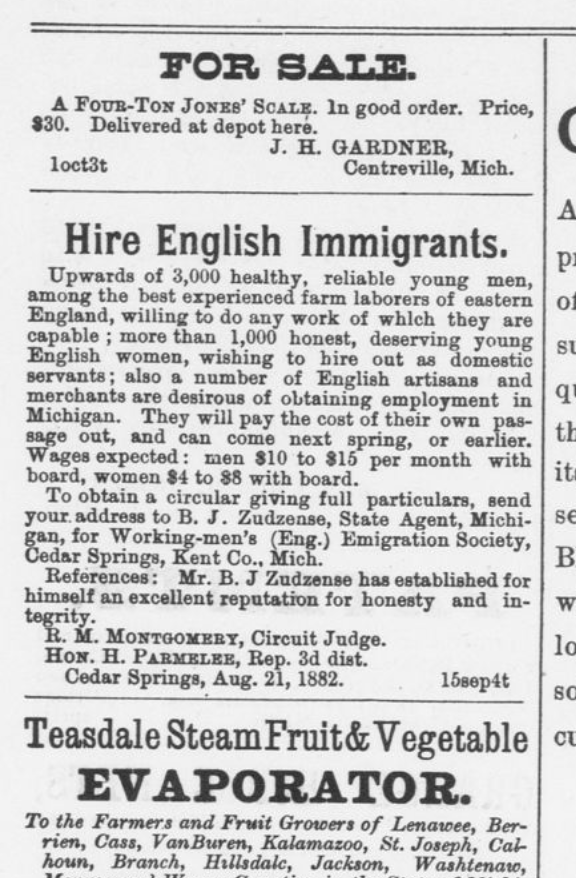
Hire English Immigrants ad placed by Mr B J Zudzense in The Grange Visitor printed on 1 Oct 1882
Benjamin said he had made the journey between America and England five times by 1882. He lectured on both sides of the pond primarily at grange meetings in Michigan and for various groups in Norfolk, England. His presentations encouraged listeners to emigrate to Michigan as farm or domestic workers to achieve a better life while they met the needs of farmers with a labor shortage. Ben worked as an "Emigration Agent" for the "Agricultural Association of Michigan".
A letter dated 11 Nov 1882 directed to a "Mr Rix" signed by B J Zudzense stated he would arrive soon with "...orders from many rich farmers and business men to solicit honest, reliable English men and women to come out to Michigan and work for them. Farm laborers and female servants are treated here as though they belonged to their employer’s family; get good board-eating at the same table as their employers-and obtain high wages. Single men are paid £4 per month. Women, general servants, with little or not experience, get £20 per year; while good cooks, housemaids, parlormaid, &c. easily obtain as much as £60 per year. Single men and women servants are provided with board, lodging and washing in addition to their wages. Married men, farm laborers, are provided with a house, garden, and all the apples they would want for their family use, and obtain £6 per month..." (published in British Immigration to the United States, 1776-1914 by William E Van Vugt)
A few days after he mailed his letter, Ben married Alvira Elizabeth Dean on November 23rd at Cedar Springs in Kent County, Michigan. She was the daughter of Courtland Township pioneer settlers, Alexander and Orra (Johnson) Dean, who came in 1839, just before Alvira's birth. The Dean family migrated to Kent County, Michigan, from Stony Creek in Warren County, New York, a small settlement in the Adirondack Mountains wilderness after a family tragedy which involved "...the mysterious disappearance of their six-year-old daughter, Lucy Dean, who was lost in the woods and of whom no trace was ever found." About seventy five years later, a local newspaper published an article, Lost little girl remembered, in August of 1910. This was revisited a century later in the Adirondack-Journal with the editor's comment, "When Lucy Dean walked into the woods near her home and vanished, she became an Adirondack legend."
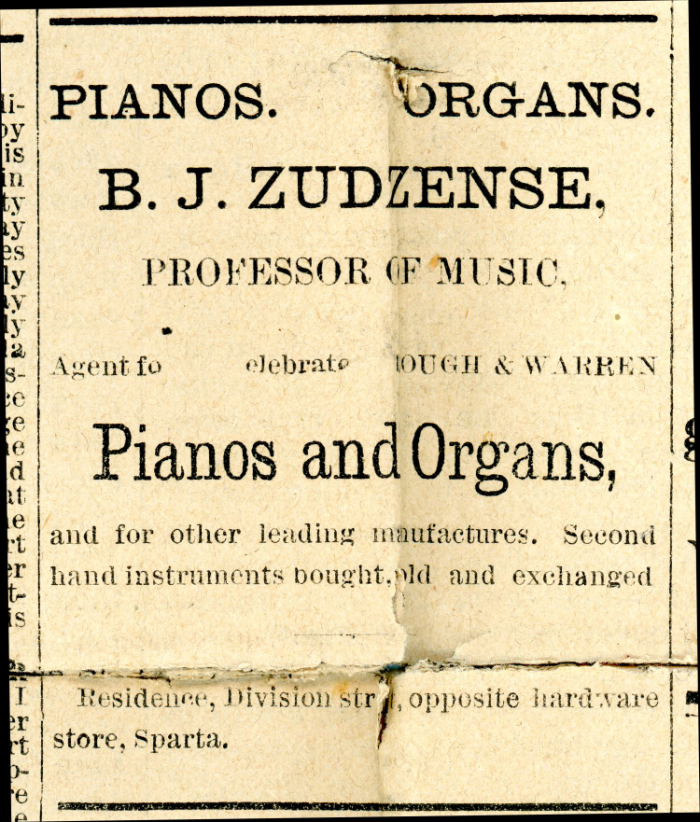
BJ Zudzense pianos and organs advertisement from the 22 Feb 1889 Sparta Sentinel, courtesy of the Karl Nickolai Collection
The marriage record for Ben and Alvira gave their ages as 31 and 42, respectively, both resided at Nelson township, and his profession was listed as a "Professor of Music".
What brought the newlyweds to Sparta?
Alvira's older sister, Eliva Sophia Dean, married Richard "Alex" Coster in 1857 and by 1871, they and their children: Hattie, Orra, Alex, Elmer, Edith, Jay, and Forest lived on a farm near Sparta. In addition to farming, Mr Coster was elected to office to serve as Constable for eight years and in the capacity of Deputy-Sheriff for four.
The Zudzenses settled nearby in the village and, in 1885, Ben resumed his studies, this time at Rush Medical College affiliated with Lake Forest University in Chicago. He graduated with his medical degree and honors on March 31, 1891. During this period, he worked as a music teacher to support his family and put himself through college. Additionally, Benjamin was listed in an 1890 issue of The Mercantile Agency Reference Book as a merchant who sold organs and pianos. One of the brands he sold, was the prestigious Clough & Warren. Their organs were known as the most ornate and expensive in America. These patented reed organs were manufactured in Detroit, Michigan, and sold worldwide. Listen to an 1879 Clough & Warren reed organ, close your eyes, and imagine the sweet music on a summer evening heard along the boardwalks near the Zudzense home.
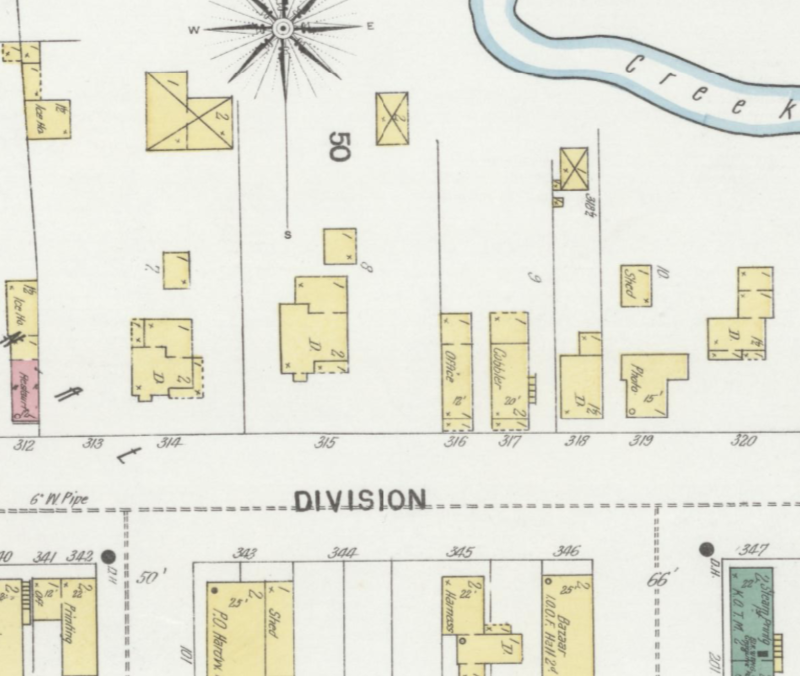
Dr Zudzense's home (lot 8 with "50" on it) and office with a bay window, a porch that faced East Division, and small barn near Nash Creek as it appeared on a 1899 Sanborn Fire Insurance map
The Doctor is in the House
Dr Zudzense's home and medical office was on the north side of East Division in Sparta between Washington and Maple Streets, across from Charles Loomis' hardware store. Back in the day, it was common for doctors to work from their homes especially since they were generally "on duty" around the clock. Today, the Zudzense's property has become the village parking lot.
After he achieved his goal to become a medical doctor and surgeon, Dr Zudzense enthusiastically began his practice. By 1892, his name appeared in directories to promote his business and he served many patients.
A nephew, William Ernest Sussens, the son of Ben's deceased brother, John, became a sergeant in the British Army. For several years, he was stationed in the East Indies. His duty took him to Burma, the Himalayans, and India. Meanwhile, a sister provided Ben with his mail address and he wrote William a letter to encourage him to come to America, suggested William might become a physician, also, and join Benjamin's practice. In the nephew's diary, which was kindly provided to me by Jenny Nebe, a great-grandniece of Ben's who lives in Australia's outback, he wrote, "How wonderful it is, what a change in a man's life can be made by such simple things; that letter altered the whole course of my life, as you will see."
Transferred from British military service with permission to reside in Canada, the soldier was provided with orders to report to Halifax and Winnipeg. William promptly made arrangements to sail by steamship to Canada. After a frigid winter crossing, he reported to the fort at Halifax then left by immigrant train. On the 3rd of February, 1898, he arrived at Essex, Ontario. He wrote to his uncle, who by return mail advised him how to "cross the river at Detroit then take the Michigan Central Rail Road to Sparta Centre," William wrote. "I finally did so and reached my uncle's home. He met me at the station and gave me a scare by trying to pretend that he was a fort official watching for me. But after the first shock I soon regained my composure."
William began his studies in March, but performed poorly. "My uncle soon became discouraged and told me plainly I could never be a doctor so we began to plan something else. Now about this time there was an American battle ship blown up called the 'Maine' in Santiago Harbour, Cuba, and great excitement and talk of war." William reflected, "I finally proposed to go and enlist at Detroit for the American Army. My uncle approved of that and got me recommendations from the clergyman at Sparta and also wrote one himself." It was April when William said his "good byes" and left Sparta.
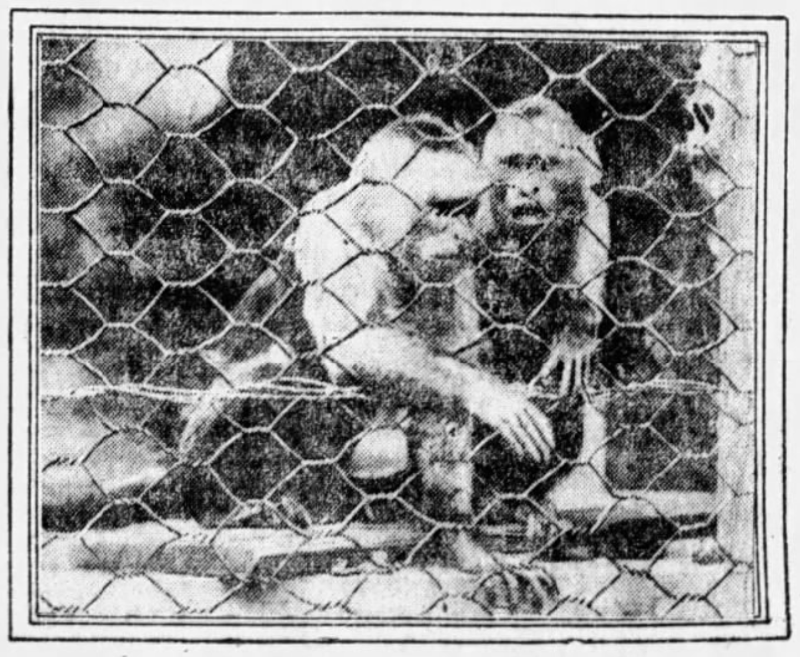
Jocko and Petie, Dr Zudzense's pet Capuchin monkeys, published by The Grand Rapids Herald
Monkey Business
Music, sound, and language intrigued Benjamin. Travel. Science. The study of animals. He had an inquisitive mind and a fascination with discovery. At some point before the turn of the century, he acquired a pair of monkeys. The how and where are not known, but from all accounts of those who personally saw them, they were described as being small. Based on a photo published by a Grand Rapids newspaper, Stacey Snyder, the Registrar at John Ball Zoo suggests they were "some species of Capuchin monkey, a New World monkey that was often kept as a pet or helper."
Native to tropical forest regions of Central America extending south to Argentina, a Capuchin was often seen as an organ grinder monkey. During the turn of the century, an organ grinder was a street musician with a barrel or street organ who performed with a dancing monkey, often dressed in a little red coat. The tethered monkey collected change from the audience in a tin cup.
The mischievous "Dexter" from the Night at the Museum movie is another example of a Capuchin.
It was the doctor's intention to use them as study subjects since he sought to understand how they interacted with each other, communicate with them, and to write a book based on his observations.
A cage was built on the front lawn with a second enclosure inside the home in front of the bay window. There was a swinging door and connecting tunnel between the two so the monkeys could move freely. Ben kept them as pets, provided them with the best of care, and they became like family. Their number increased, but it seemed apparent his favorites were those named 'Jennie' and 'Jocko'. A third, called 'Petie', became notoriously well known.
I Remember
by Arzie L Pinckney
MORE ABOUT DR ZUDENZEE & HIS MONKEYS
"The monkeys would watch them (the ladies) coming down the street, and just as the women got under the tree, they would swing down and try to grab some of the things off their hats."
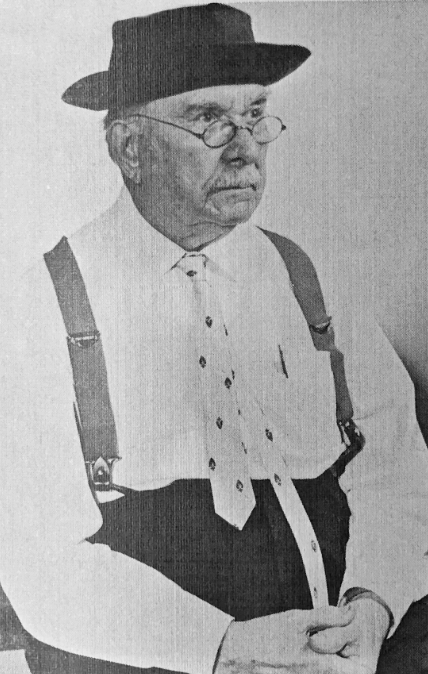
Arzie Pinckney in 1971, from the Sparta Area Quasquicentennial book, copies available at STHC research center
I suppose that the stories about the good doctor's monkeys are legend. When they were young, the doctor would let them out-of-doors and run loose if he were at home.
I remember the row of beautiful maple trees that lined that side of the street. The monkeys loved to climb them and drop things on the folks going by, especially on the ladies. In those days, women wore big hats and usually decorated them with flowers, and sometimes, fruit. Well, that was "duck soup" for those monkeys. They would watch them coming down the street, and just as the women got under the tree, they would swing down and try their best to grab some of the things on the hat. If they did get hold of anything, it was their property for if the doctor wasn't right there to make them give it up, there wasn't much left of that hat, for it didn't last long.
I do not remember who it was but one time a woman was passing by and she had what looked like a bird on her hat. Well, you can guess what must have happened then, for the monkeys were up in the trees and she never thought of that possibility.
Some of the young fellows who had the nerve would stop and feed them with peanuts and they soon got to know them well enough and would sit on the fence posts and wait for them.
Such was the case one day when our brother, Clarence, and his friend, George Neal, came along. They stopped to talk to the monkeys and George took out a cigarette and lit it. The monkey watched him as he scratched the match on the side of the post. The monkey wanted that match, so not heeding Clarence's advice, he gave the lighted match to the monkey. As might be expected, the monkey burned his hand. Of course that was funny to everyone but the monkey. I believe the doctor called him Peter. Then the boys went on up the street.
Later as they were coming back, the monkey saw them and jumped back upon the post. George said, "I wonder what he would do with a match that was not burned." Clarence told him that he would eat it and it might make him sick. So he gave the monkey the match, and before the boys saw what the monkey was doing, he scratched the match on the post and stuck it on George's hand. Of course, it burned his hand. I suppose that George always wondered just who got the most fun from that prank.--published on 26 Feb 1969 in The Sentinel Leader
Continued the next week...
I do remember one time when the housekeeper came home from the store with some groceries including a five pound sack of sugar. She didn't know that the monkeys were loose in the house so she left the groceries on the kitchen table and went up to her room to change her dress. Mrs. Zudzenzee heard a riot going on in the kitchen and called the maid who rushed downstairs and into the kitchen only to find that one of the monkeys had grabbed the sack of sugar and was chasing the others around the room hitting them with the top end of the sugar sack. Naturally, the sugar was all over the floor. And that was just an ordinary day with the monkeys.--published on 12 Mar 1969 in The Sentinel Leader
Ben's sister-in-law Eliva (Dean) Coster became afflicted with Tuberculosis and the disease took her life. She passed away on May 1st, 1901. A few months later in October, Alvira suffered a fall that resulted in a fracture of her left hip and left her an invalid. Relatives remarked that Ben always treated his wife with loving kindness. The devoted husband tenderly carried her across their sloping back yard down to the banks of Nash Creek, which flowed behind their home, to take her for boat rides. The couple cherished their private time spent with one another.
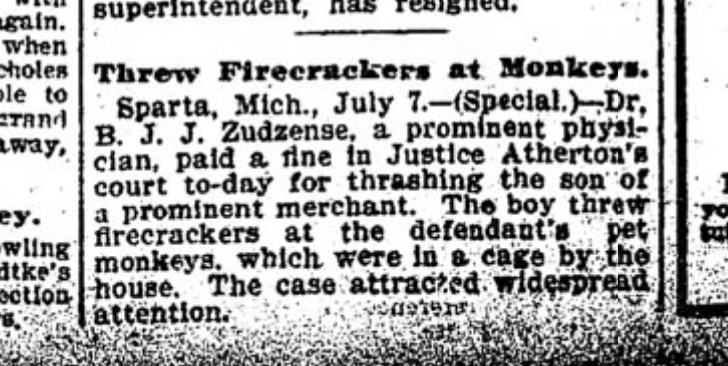
News item in the Detroit Free Press, July 8, 1902
The monkeys attracted plenty of attention. Sometimes, too much.
Terrible Times
At the start of May in 1906, the doctor arrived to stay at a home at 340 Lyon street in Grand Rapids. It was between Lafayette and Prospect, just a couple of blocks away from the U.E.A. Hospital where he sometimes saw patients. He set up a room for two of his monkeys, Jocko and Petie, who accompanied Ben to the city. Somehow, their glass window was broken in the early morning hours of the 16th and the furry pair escaped.
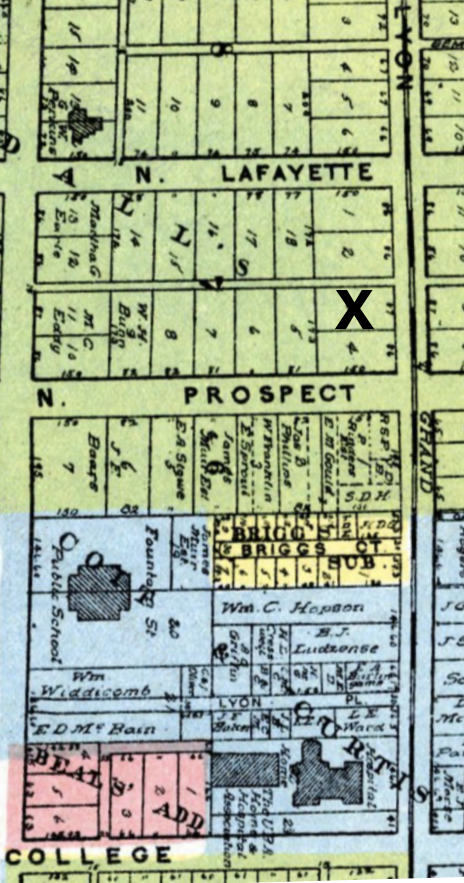
Lyon Street home marked with an "X" while Briggs Court appears in the yellow area
The primates made their way east a very short distance to 53 Briggs Court. There, they entered an open bedroom window where a five-year-old boy, Riford Worth, was asleep. A news account from the hometown of the boy's uncle, in the St Joseph Evening Herald, described what happened: "The boy will recover from the terrifying attack made upon him Wednesday morning by the two monkeys, which broke into his bedroom, and, after waking him from sleep, scratched his face and head, bruised his arm, and threatened him with a knife they had captured from an adjoining residence. His face shows the plain marks of the vicious claws of the simians, and he may bear a scar over his right eye for some time. His parents had some fear he might have sustained a nervous shock as a result of his fright, but he seems to have borne the exciting experience without harm."
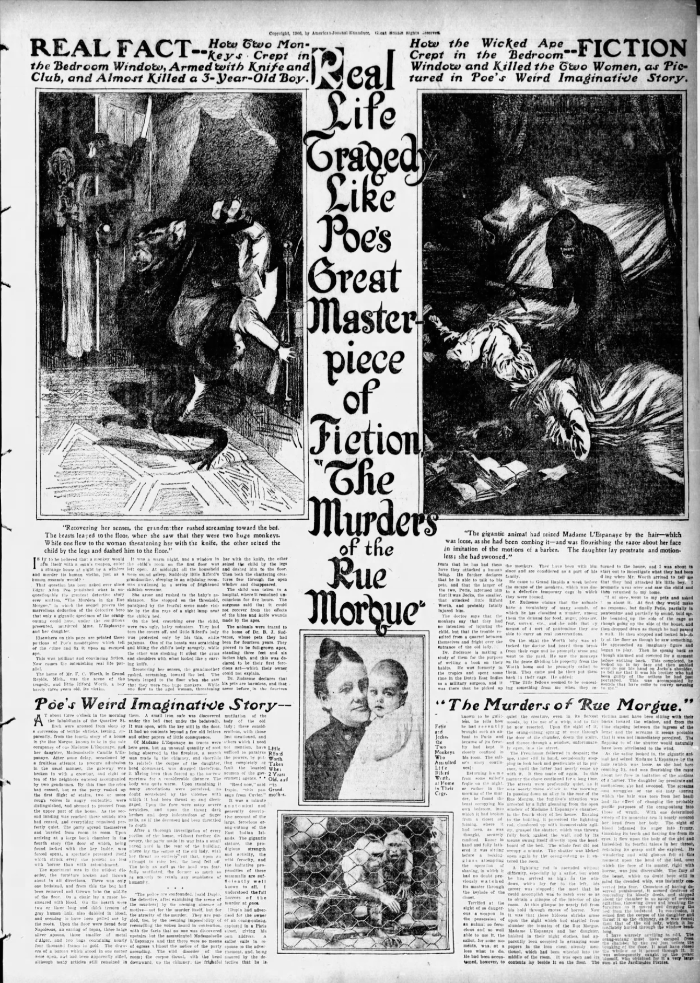
Sensationalized and deceptive report from The San Francisco Examiner dated 3 Jun 1906. Photos of the monkeys and the boy with his grandmother originally published in The Grand Rapids Herald
Other local articles stated it was a jackknife from a nearby home where carpenters worked which was found in the room after the monkeys fled through a window. It was not believed the knife was used to cut the boy. The child's grandmother, Hattie Riford, interrupted the attack and rescued the lad. Dr Zudzense "captured the monkeys without any trouble", made apologies, and said he had had his pets for fourteen years. If accurate, he obtained them about 1892.
Newspapers across the country eagerly printed the story, often with embellished details. Exploitive headlines declared the child was murdered. Most assuredly he was not. Riford grew to manhood, married, served in WWII, and lived out his life in Grand Rapids, Michigan.
Quite possibly the most brazen example of tabloid journalism was committed by The San Francisco Examiner with a full-page spread that compared the incident to the gory fiction of Edgar Allen Poe's The Murders of the Rue Morgue, complete with ghastly artist renderings. A drawing depicted one sinister monkey hidden behind the door with "what looked like a large carving knife" clutched in his hand as grandma peered into the room while the larger muscular monkey held the boy upside down by his ankles and dangled the child's head above the floor. The monkeys were falsely described as "full-grown apes standing three foot and six inches high". They outlandishly claimed the monkeys brought a knife and a club, to suggest that the act was somehow premeditated. They conveniently reduced the boy's age to three years and openly lied as they wrote the hospitalized child "remained unconscious for five hours" with surgeons who stated he "could not recover from the effects of the bites and knife wounds made by the apes."
I won't comment on the specifics of the rest of the article other than to say the doctor's character was assassinated by the sleazy newspaper as he was ridiculed with conjecture and boldface lies. Lies which were clearly and deliberately designed to sell their rag and put profit in their pockets at the expense of truth.
A Heart of Gold
The benevolent Sparta doctor generously provided entertainment for benefit concerts. One such event, held in 1907 at the request of the Epworth League, raised money for the Methodist church's organ fund. "Dr B J Zudzense will give a concert by means of his new $400 Auxetophone January 10. This apparatus, with records costing from $4 to $6 each, reproduces accurately and beautifully the voices of the world's greatest singers," reported the Sentinel Leader.
At another concert arranged to benefit Rev Levi W Caulkins at the Methodist Church and scheduled for March 11, 1908, the doctor brought his Auxetophone to play eighteen selections. Admission was 25¢ per couple or 15¢ for a single person, with an extra 5¢ to reserve a seat. Seats sales were available at Bolender's drug store. All proceeds were given to the minister.
An Auxetophone was invented by an Englishman in 1904 as an early type of phonograph which used compressed air and a large horn on top of a wooden cabinet to amplify the sound. The Victor Talking Machine Co of Camden, New Jersey, manufactured them from 1906-1918. Only about 500 were sold during production because they were quite expensive. Benjamin had bought his at a very good price as they usually sold for about $500 in 1906, which in today's money (2023) would be $16,620.56! Consequently, these machines were purchased by business establishments such as dancehalls, restaurants, or hotels. So when the kind doctor brought his to an event, it generated public enthusiasm, and the crowds came, too.
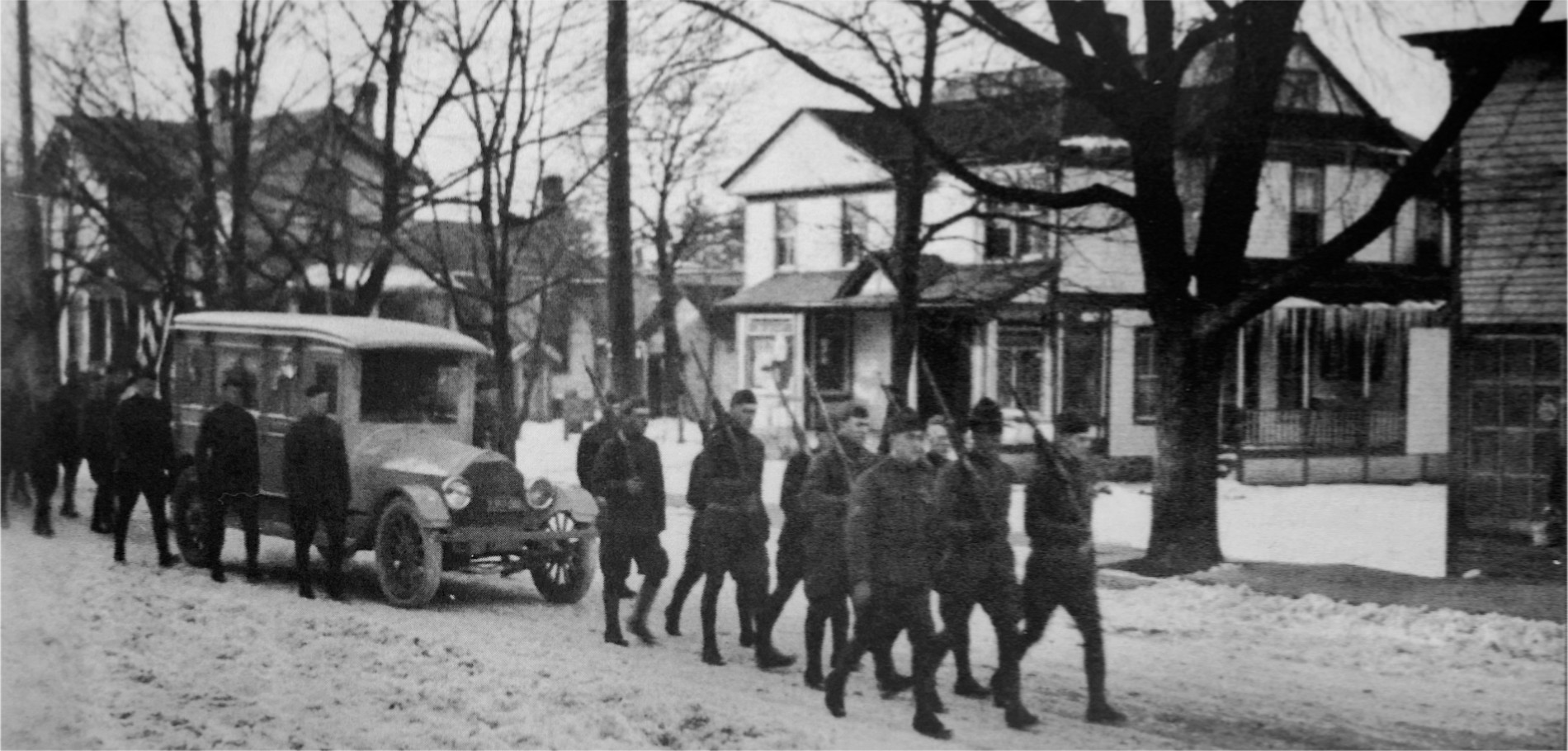
The late Dr Zudzense's home, as it appeared about 1919, center, photo taken during a funeral procession of a WWI soldier headed east on Division to Myers Cemetery. By then, Mr and Mrs Ed Roberts purchased the home and their daughter, Rose, who had a millinery business, and her husband, Noble Gaut, resided in it. The Morris Haas home on the left was later moved to 90 Mark Street. Part of a commercial structure along the road can be seen on the right. The 1918 Sanborn Fire Insurance map labeled the narrow building as a barber shop
Benjamin kept in touch with his nephew as he served in the Army. As with many soldiers sent to tropical jungles, William contracted malaria. Over the years, he suffered recurring bouts of the disease. The uncle extended an invitation to him provided he would assist with the housekeeping. William accepted the offer and upon his discharge, took the train and arrived at Sparta on November 6th, 1908.
"November 26th - Thanksgiving day and wrote this diary in my room. Am in better health and getting along alright, like it very much after Army life. I hope I've finished soldiering. Aunt Vera Zudzense (is) very sick, Uncle in poor health, glad to see me again, he is expecting to return to England in 1909 shall perhaps go with him." Two months later, William left for England on his own. A young man who struggled with conflict, the nephew's hasty departure was timed precisely as his uncle entered the eye of the storm.
Death's shadow fell upon the Zudzense home. On March 17, 1909, Tuberculosis claimed Alvira's life.
"It is with sorrow that we note the departure of one of our number, Mrs Zudzense, who was promoted to higher life March 17, after an illness of more than a year. Sister Zudzense had been an earnest, interested member of the W.C.T.U. for many years. She had a gentle, loving disposition, and bore her sufferings with great fortitude, and a cheerful spirit. She was a faithful Christian, and for a long time had been patiently watching and waiting for her Saviour to beckon her home. The sorrowing husband, who is bereft of a loving companion, has the sympathy of a large circle of friends. The funeral services were held at the house Saturday, March 20, in charge of Rev M W Duffey, pastor of the Methodist church. The many floral offerings were fine, especially a beautiful floral piece by Dr Zudzense, with the very appropriate words, "At Rest".--Sentinel Leader
A Showdown at the Ballot Box
No doubt the street paving controversy, his false arrest, and imprisonment inspired Dr Zudzense to toss his hat into the ring in an effort to bring about what he viewed as needed change. The public agreed. The board president was replaced, as were four of the trustees. Ben, a member of the Law and Order party, was among the newly elected trustees. The March 18, 1910, issue of the local newspaper described his jubilation: "The Doctor was so elated over his success that he forgot his loyalty to dear old England (don't yer know?) and permitted the stars and stripes to float from his residence all of the following day, while the remainder of the household ("Jocko" and "Pete") danced the "can-can" in celebration of the event."
"No more use for the sign, "Keep away from these monkeys," The doctor has erected a 6-foot wire fence to prevent further annoyance," the Sentinel Leader reported. The fence provided the doctor with peace of mind while he made a trip to England. He left right away on the steamship Teutonic and docked at Southampton on June 16th. Ben only stayed for thirteen days then made his return trip on board the Oceanic and came into port at New York on July 6th.
Rest in Peace
On a furlough from duty, William returned to Sparta and saw his uncle, who "had just returned from England, looking well." The visit was brief. William returned to duty and transferred to a recruiting service position at Grand Rapids. On August 3rd, Benjamin's heart gave out and he passed away. William arrived in Grand Rapids on the 14th, unaware of his uncle's death until September 5th, when he received a letter from his brother, Fred.
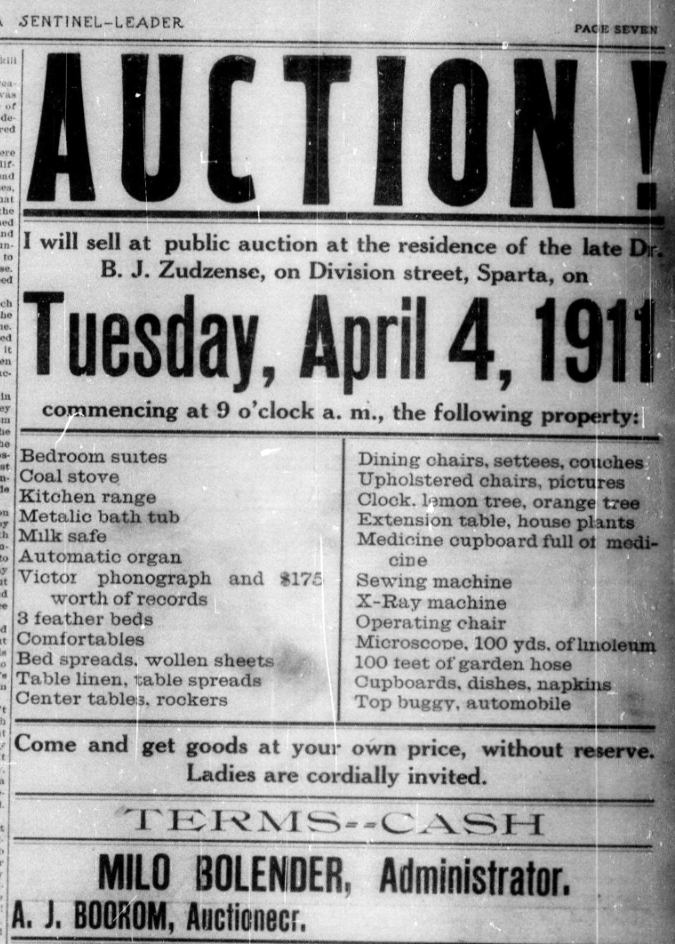
April 4, 1911, estate auction notice from the Sparta Sentinel-Leader
The Evening Press declared:
HEIRS ARE FOUND
Administrator of Zudzense Estate Succeeds in England.
NAME IS DIFFERENT
Nephews and Nieces Are Known as Sussens Family.
Probate Court is Asked to Allow Bolender to Sell Property at Sparta.
Further information concerning the life of Dr Benjamin J Zudzense, Sparta's eccentric citizen who died some time ago, was made public today by the filing of a petition in Probate court asking the right to dispose of about $3,700 worth of real estate now in the hands of Milo Bolender, the administrator. The Zudzense six heirs who were discovered recently by the administrator are members of a family by the name of Sussens.
Bolender was appointed by the court after the will supposed to have been left by Dr Zudzense could not be found and but recently returned from a trip to England where he went to get track of the heirs. The trip was taken at the expense of the estate. That his mission was successful is attested by the fact that waivers allowing the realty sale were secured from the hitherto undiscovered heirs. It is also said that Bolender recovered about $5,000 in securities belonging to the estate from the Bank of England. The heirs signing the waivers are: Martha Pitcher (who was actually Ben's last surviving sibling), Castle Acre, England; Frederick A Sussens, now a resident of Australia; Harriet E Sessions, London, England; Ellen K Sussens and John J Sussens of Gillingham, England; and William E Sussens of Washington DC. The heirs are nephews and nieces of the deceased.
The real estate to be disposed of consists of property located on the banks of Nash creek in Spaarta, valued at $2,000; a lot in Sparta worth $900 and equity in real estate here valued at about $800.
Probably a complete unraveling of the mystery concerning the life of Zudzense will take place when Bolender files his first annual accounting as administrator of the estate.
During his life Dr Zudzense was best known for his attachment to two pet monkeys. Shortly after the death of the doctor one of the animals died. The other is now a stuffed inmate of Kent Scientific museum. The doctor asserted he was able to talk in monkey language to his pets.--The Evening Press was a publication of the Grand Rapids Press, dated 24 Jun 1911
"When he (Dr Zudzense) passed away," Arzie Pinckney wrote, "the property was sold to Mr and Mrs Ed Roberts. He was a carpenter. They had a daughter, Rose, who was a milliner and set up shop in the front of the house. Later the Federal government bought the property and razed the buildings with the intention of building a post office there." Mr Pinckney added, "On July 29, 1959, the Village bought the lots and made it into the present parking lot."
DO YOU REMEMBER WAY BACK WHEN...
JOCKO AND JENNIE WERE RESIDENTS OF SPARTA?
Jocko and Jennie were the pets of Dr B J Zudzenzie. There may have been other monkeys in the group but Jocko and Jennie were undoubtedly the favorites.
Jocko and Jennie were the pets of Dr B J Zudzenzie. There may have been other monkeys in the group but Jocko and Jennie were undoubtedly the favorites.
Spartans of today will recall how they used to run screaming when Jocko and Jennie would get out of their domicile and go wandering or possibly one should say scampering about the town. That was some 30 or 35 years ago.
Dr Zudzenie, a good doctor but an unusual character and sometimes seeming to border on the eccentric, owned the house now occupied by Noble Gaut. In addition to the large screened in outside cage there was a smaller inside cage occupying the front bay window.
The doctor and his monkeys were great pals and the children of the community liked the simians too--when they stayed in their cages. But when they got out, as they frequently did, it was different for the monkeys took a particular delight chasing anyone who would run and with their shrill screams added to that of the youngster it was thrilling indeed.
The monkeys chose any time that was opportune for their wanderings. One Sunday afternoon they made a break and Jocko, or possibly it was Jennie, who was cornered in Rev Caulkins, the Methodist minister's woodpile. The children who got a great thrill in following the doctor at a safe distance, gathered around and watched the doctor entice the monk with a raw egg.
Although it created considerably more than a desirable amount of commotion for a Methodist minister's Sunday afternoon, Rev Caulkins was ver generous and not only contributed the egg to tempt the little monkey from his hiding place in the woodpile but seemed to get considerable amusement from the situation.
With the passing of Dr Zudzenzie, the monkeys passed out of the life of Sparta. Just what became of them I do not recall. Possibly someone will remember whether they were sent to monkey heaven by the sleep route or were given to some one.--by an anonymous "Sparta Sr." published in the Sparta Sentinel-Leader on 15 May 1931
Jumanji Sparta Style!
A response was written by pharmacist and a former resident of Sparta, Nora Mitchell. She was the sister of Clara Bolender, Milo's wife.
Over the Pharmacy Counter - Michigan Soldiers Home
By Nora I Mitchell
"THE MONKEYS DIDN'T COME"
Am back "On Duty" behind the Pharmacy counter after a week's vacation in the Northland where the Christmas trees grow in abundance. We traveled miles and miles through a dense forest of evergreen trees on both sides of the road. Spent one day at Sault Ste. Marie and watched six big boats come through the locks. Two of these boats were 600 feet long--big ore boats. These locks are the longest in the world--learned that in the Sparta Monday Evening Club. One night there was quite an argument about it, so it was remembered.
The day we visited Mackinaw Island my sister, niece and I were seated at a table in a cafe on the main street of the city of Mackinaw, eating our dinner when a little lad of not more than six years, in a khaki-colored cowboy suit came in. He strode past us, holding his close cropped tow head high. He walked straight to the counter upon which the big coffee urn was sitting. Evidently, it was his mother who was serving coffee and pouring it, for the waiters to carry to the waiting patrons. Anyway he called out so everyone in the room must hear unless they were deaf. "You told a lie." Then raising his voice still louder, he said, "You told a lie, Mother. You said the monkeys would come and they didn't. And I wanted to see them. You told me a lie." She took the lad into an adjoining room and probably had a conference with him; but he left unconvinced for he sang out over his shoulder as he passed our table on his way to the door, "You told a lie, and you'll go where the devil lives." We were old fashioned enough to cringe at that--a youngster of that age talking thus to his mother. I remarked, "Well, that lad had remembered some good orthodox teaching some one has given him."
The incident brought to my mind what an attraction those two little monkeys in a cage--a part of Dr B J Zudenzense's home--were to the children of Sparta. They were unusual pets, named Jocko and Jennie, belonging to the old doctor. When they escaped from their cage, as they did occasionally, what a scampering of little feet--yes, and older ones too--when the cry went forth, "Old Zud's monkeys are out."
Every new child coming into town was taken down to that end of Main street to see the monkeys; but when they were out no one wanted to get very near them.
I will not forget how frightened the children of our neighborhood were one morning when the monkeys were out and one had bitten a little Johnson girl on the arm. Her home was down on the street where the old Holm plant was built later. She had been to the post office and had stopped for one more look at the monkeys, when they squeezed through the door and attacked her.
What became of Zud's monkeys? Jennie died and was buried by her master. Jocko lived a little over a year after Dr Zudzense died. Then the administrator of the estate finally gave him to the Grand Rapids Museum, and was very glad to be rid of the nuisance. Anyone caring to see Jocko can do so by going into the Grand Rapids Museum, for they made two mounts of him--one of his skin is as natural as life--and also one of the skeleton.--published in The Sentinel-Leader on 21 Aug 1931
Good question... what became of the Doctor's Monkeys?
Of course, Nora Mitchell being the sister-in-law of the administrator of the good doctor's estate, Milo Bolender, would be in the know.
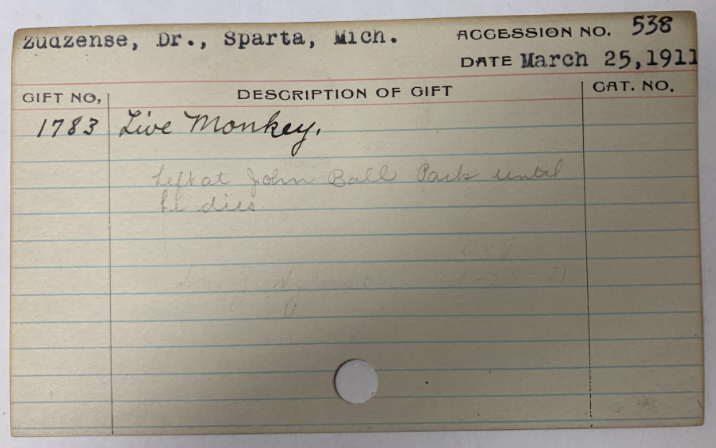
Museum roladex card record of "Live Monkey" donation received on March 25, 1911--courtesy of Andrea Melvin, Collections Curator, at the Grand Rapids Public Museum
Six months after the doctor's passing and with just one monkey remaining, Milo was eager to place the last little buggar into someone else's care. He tasked Attorney Anderson with writing a letter to Judge Jewell seeking his advice regarding the "disposal of the animal that has become a burden". The Evening Press, a publication of the Grand Rapids Press splashed the headline "GIVE MONKEY AWAY--Administrator of Zudzense Estate Wants to Do It." across the top of an article in their Feb 24th, 1911, issue. It went on to ask, "Who wants a monkey? Not an ordinary one of the common variety, but one which has achieved some fame as one of the collection of the late Dr J B Zudzense of Sparta." With no takers, a month later, the little monkey's ownership was officially transferred to the museum. A penciled notation on the donation card indicated it was "Left at John Ball Park until it dies."
Once in the possession of the John Ball Park Zoo, surprisingly it was only a matter of days before the sole surviving Zudzense monkey made headlines. Although some Sparta residents thought it was Jocko, a news item stated it was Pete. Either way, it was the only one left.
Where to begin? This was entirely preventable. The monkey should never have been sent to such an event. It is unclear whether Fishman was associated with the Y.M.C.A. or was just a bystander. Regardless, he had no business opening the cage for any reason whatsoever and his ineptitude was directly responsible for his own injuries. Shame on whoever wrote this piece of yellow journalism, as they sensationalized the story and demonized the monkey.
"Poor Petie," commented John Ball Zoo's Stacey Snyder, "it looks like he was euthanized for behaving like a monkey."
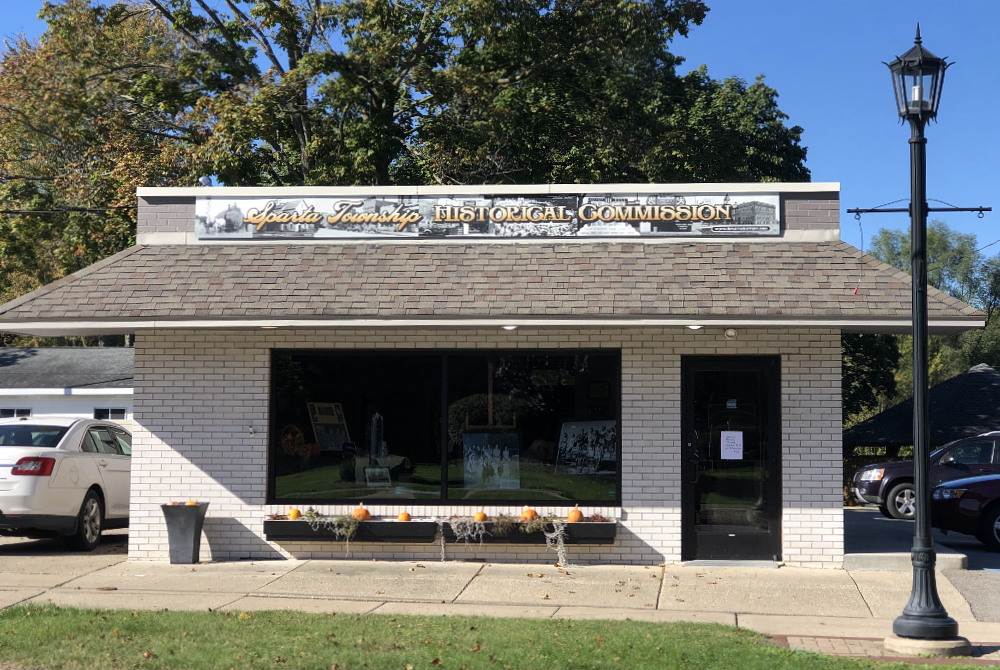
Sparta Township Historical Commission headquarters at 71 North Union Street
Our History Center is conveniently located at 71 North Union Street in downtown Sparta. Please join us for coffee and lively conversation on Monday mornings. Visits to the History Center can also be scheduled by appointment, for your convenience.
We do not receive mail at the History Center, instead, please use our mailing address, which is:
attn: Sparta Township Historical Commission
Sparta Township
160 E. Division St.
Sparta MI 49345
Our complete archives are now available online for your convenience. Just click STHC PastPerfect Catalog Access and begin your research!
For other inquiries, the Sparta Township Historical Commission can be reached by phone at: (616)606-0765 or via email at the following address: